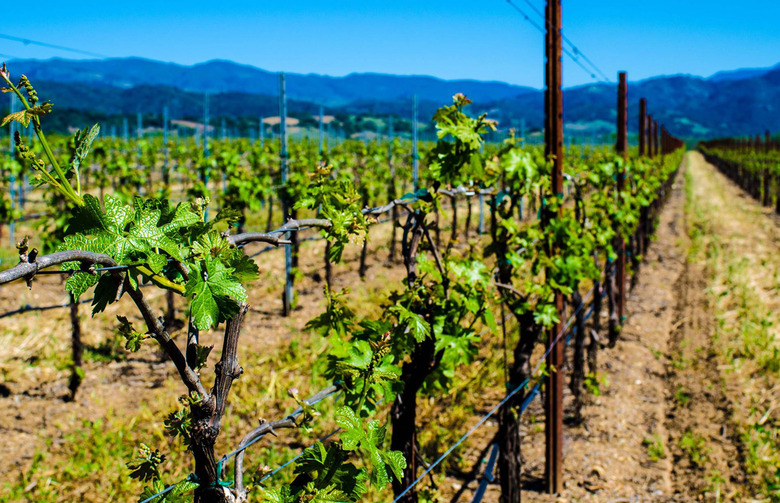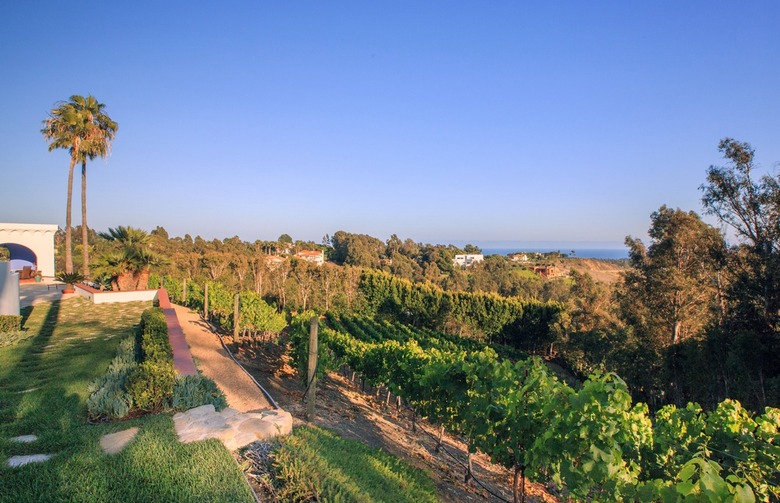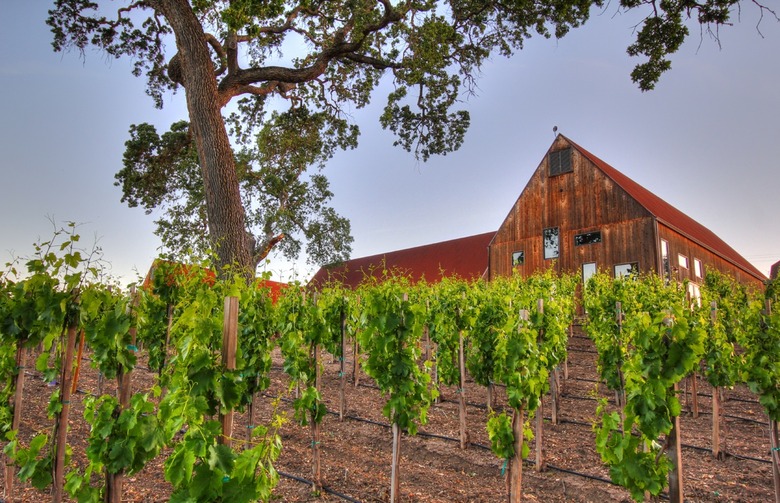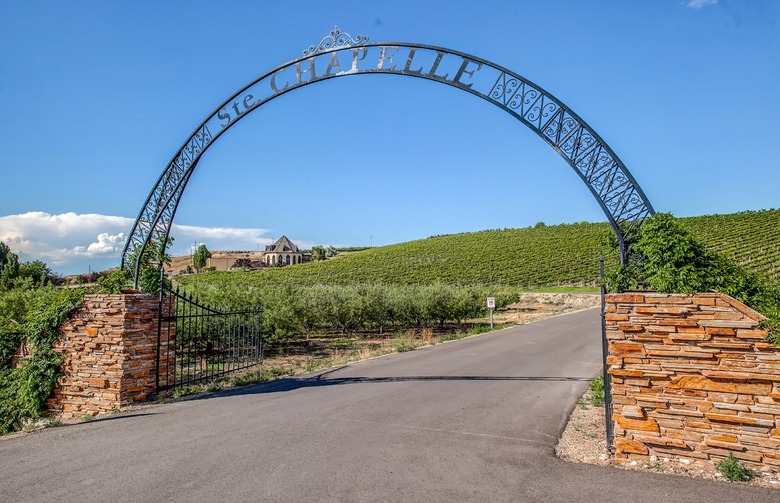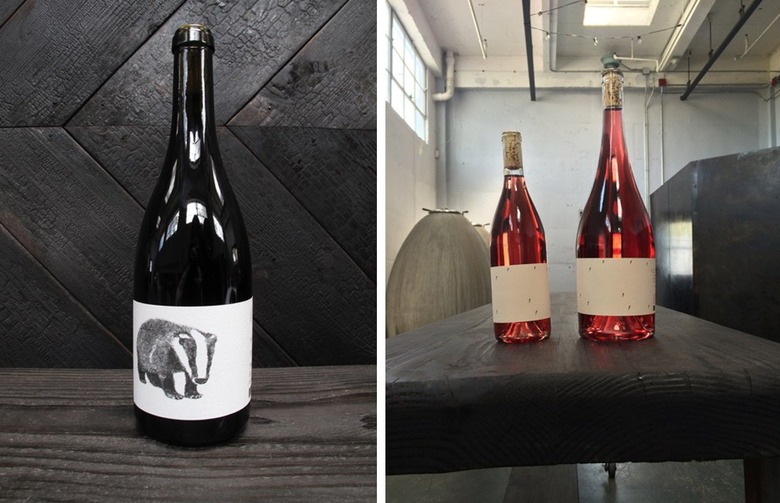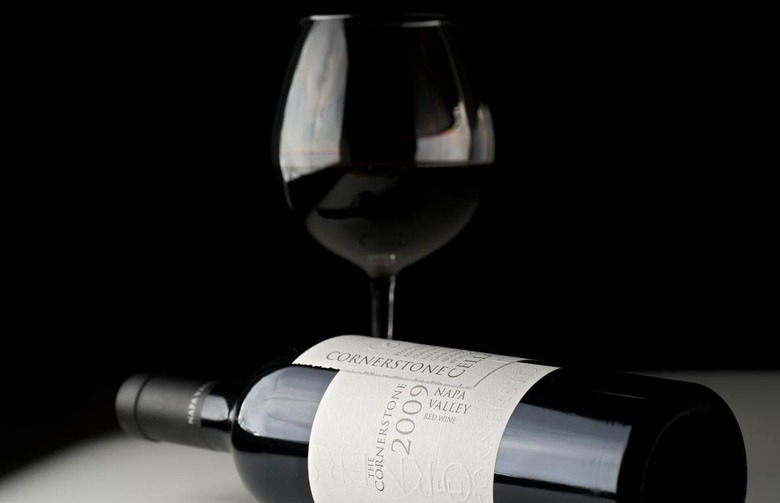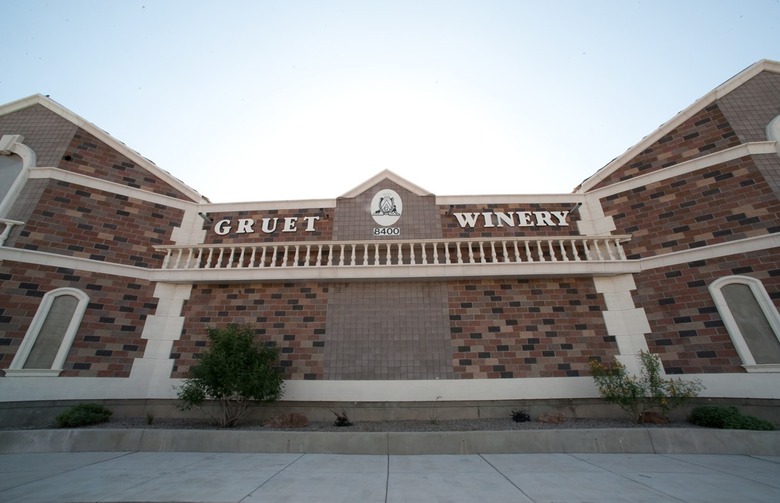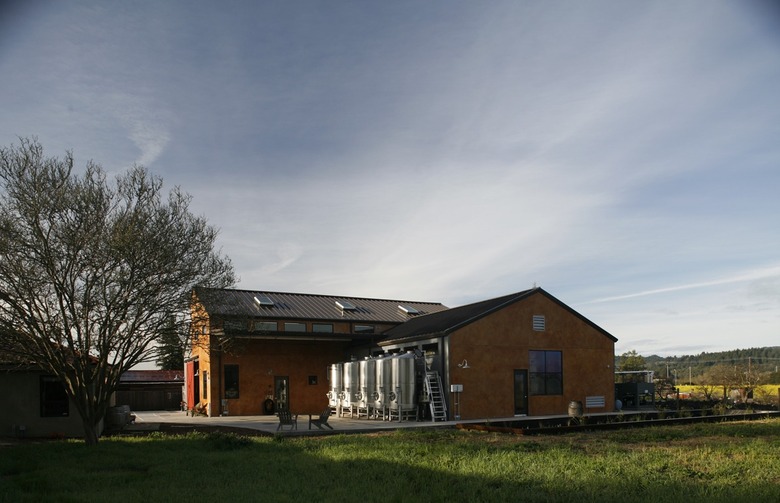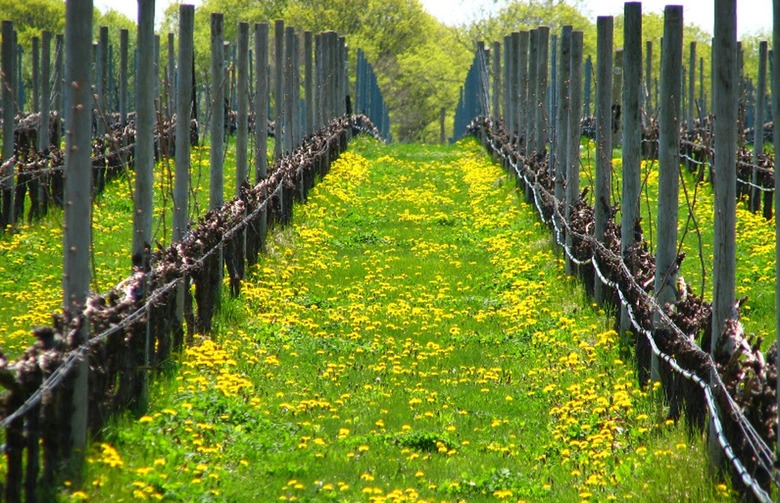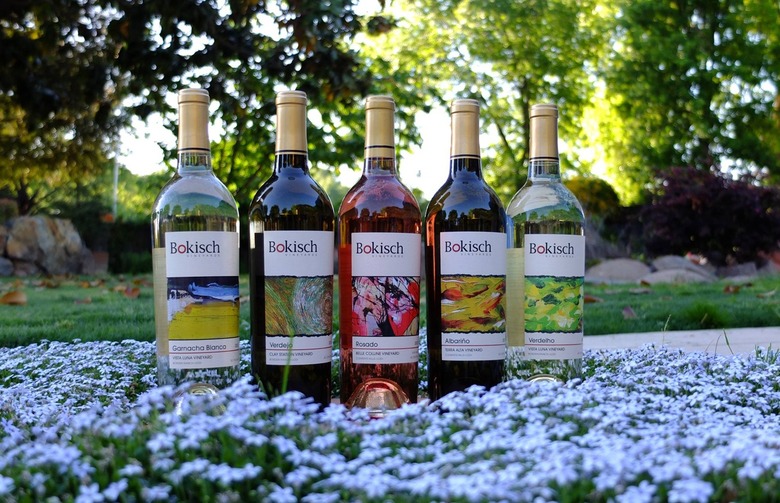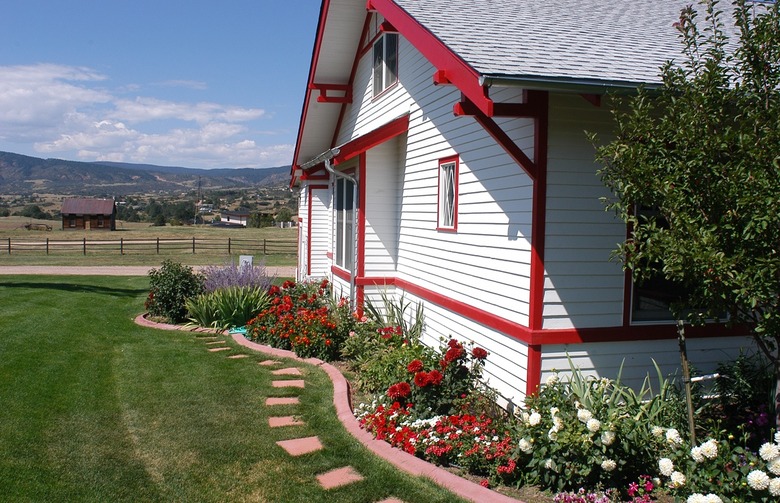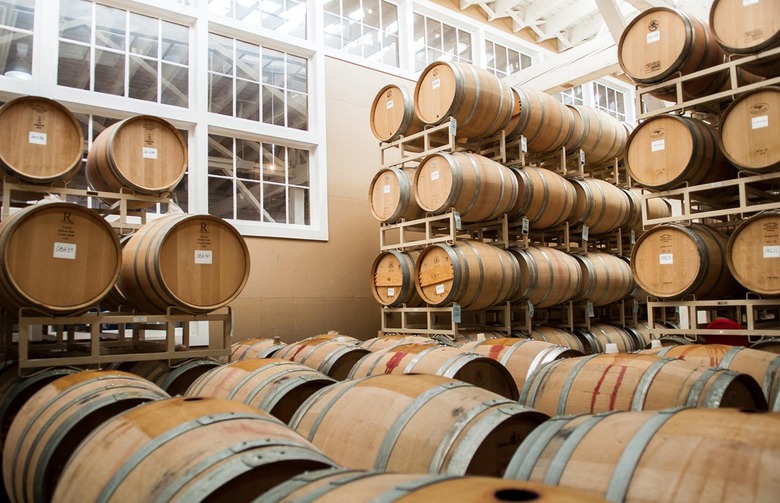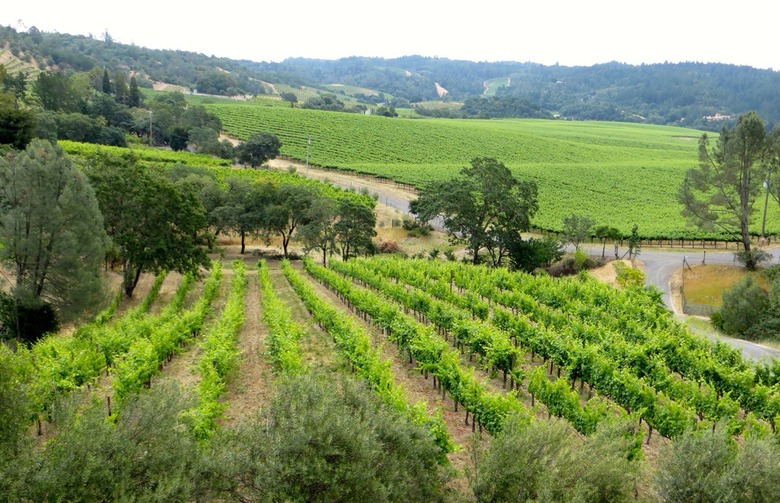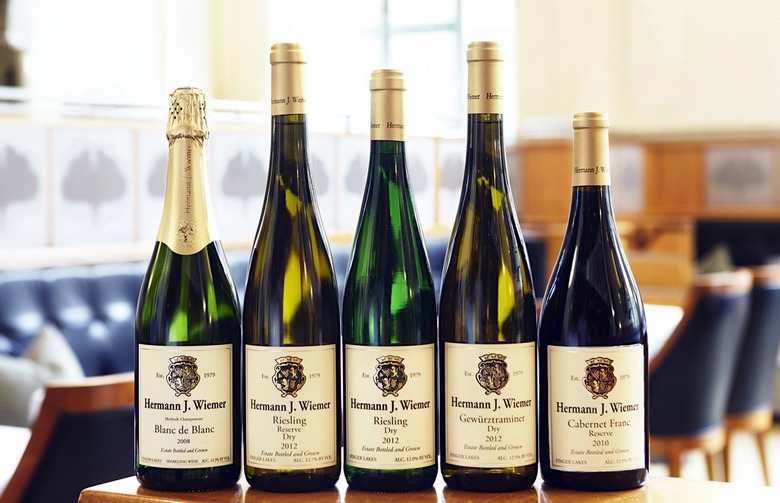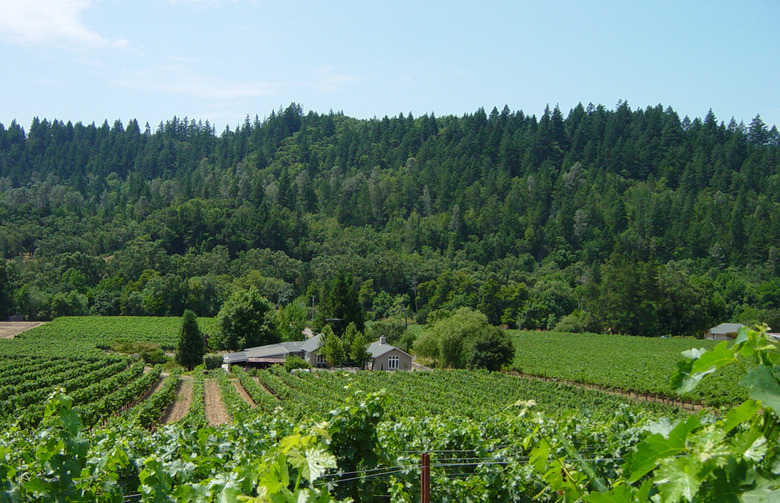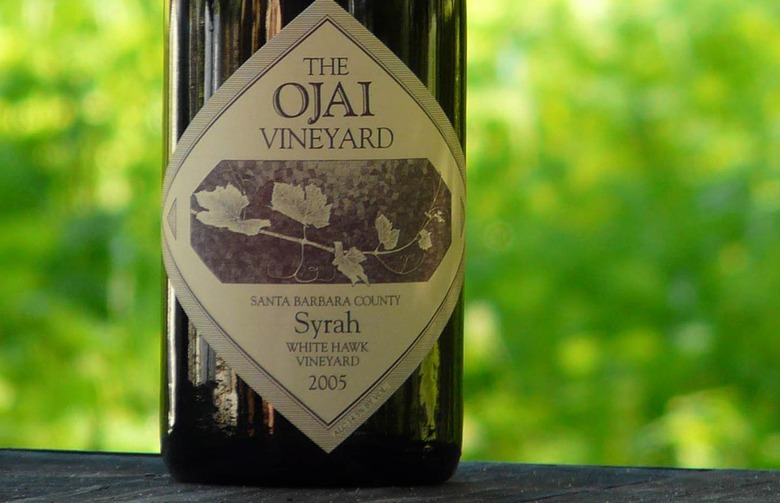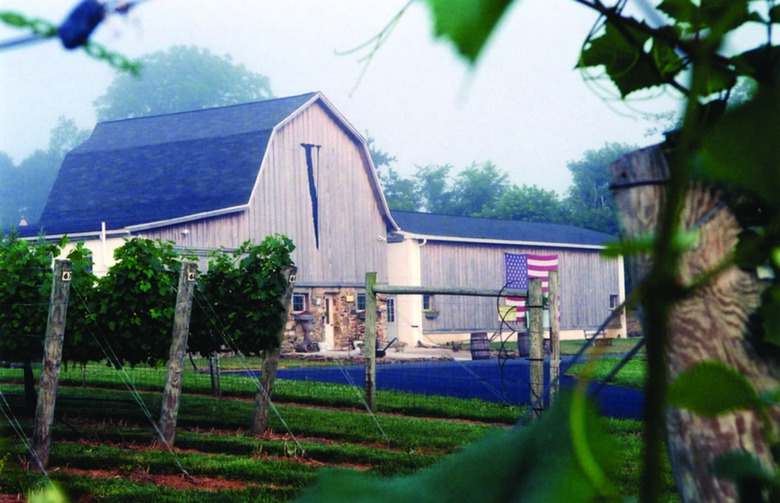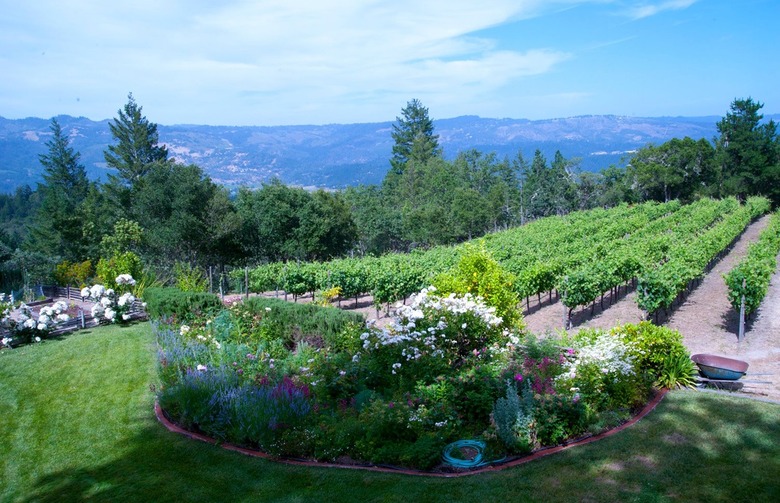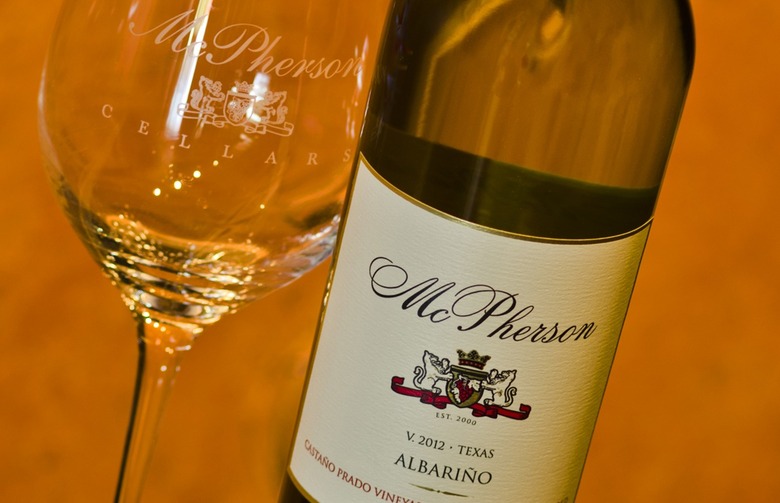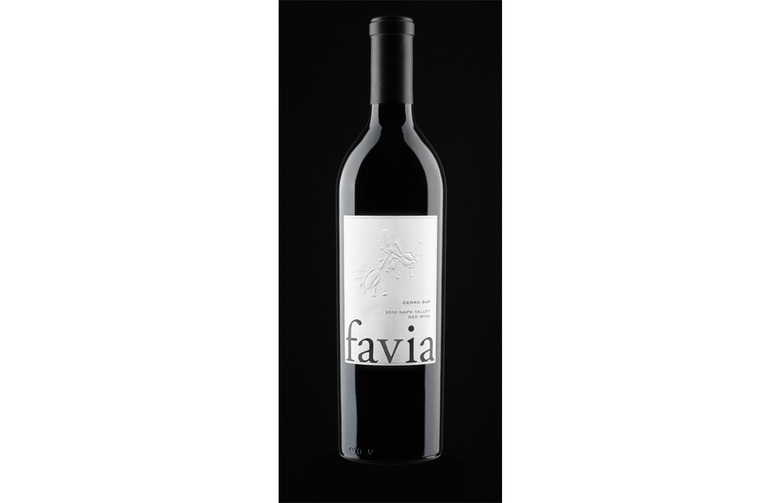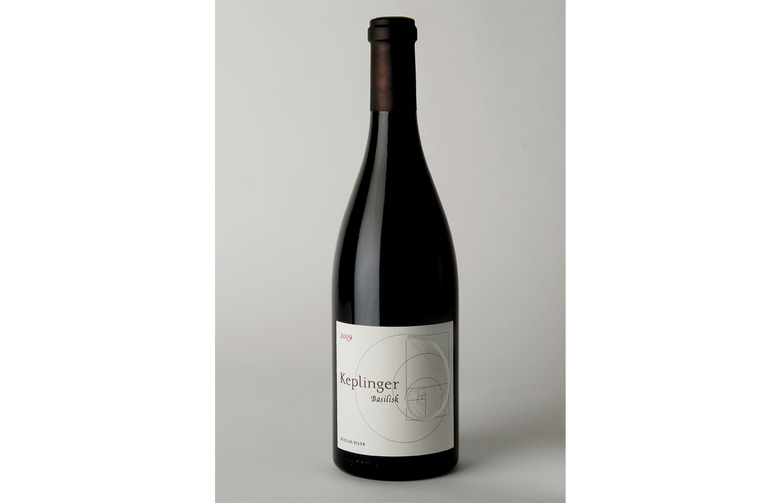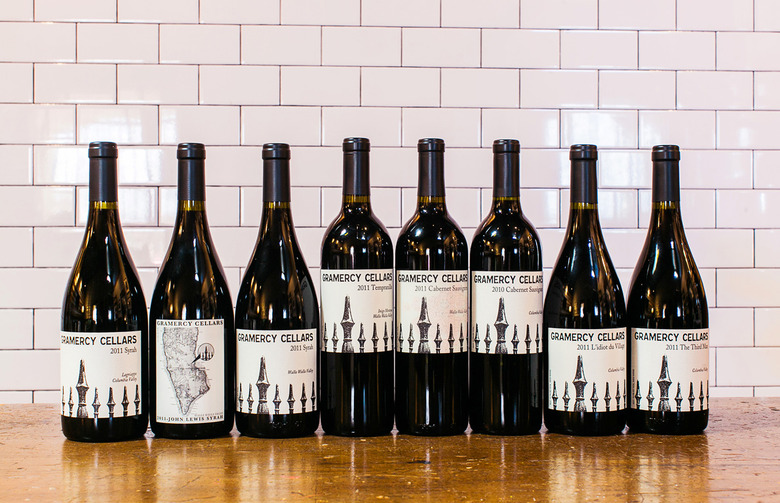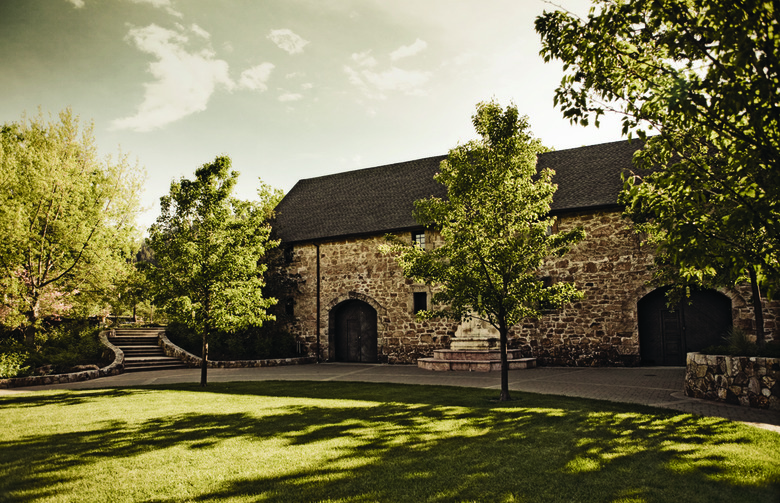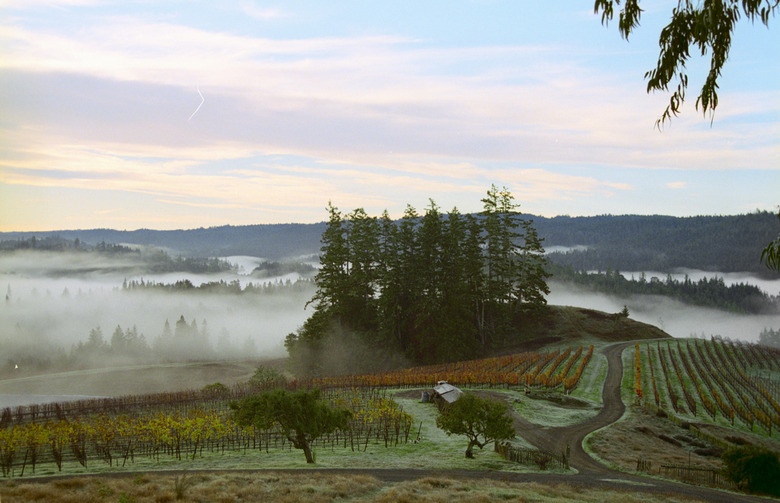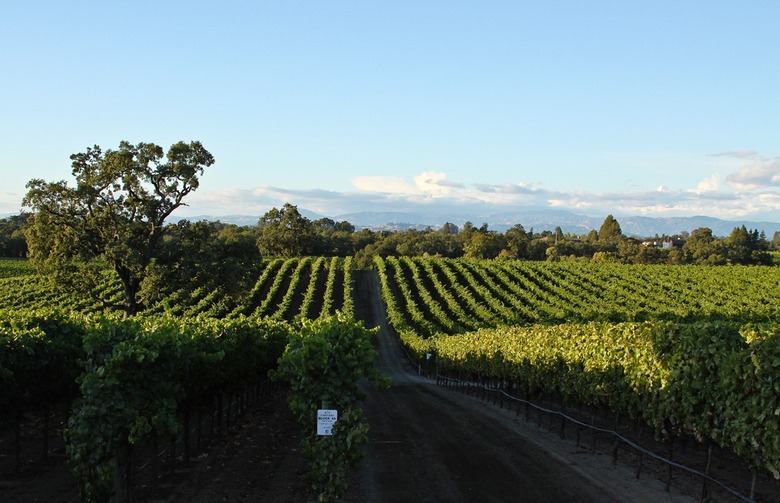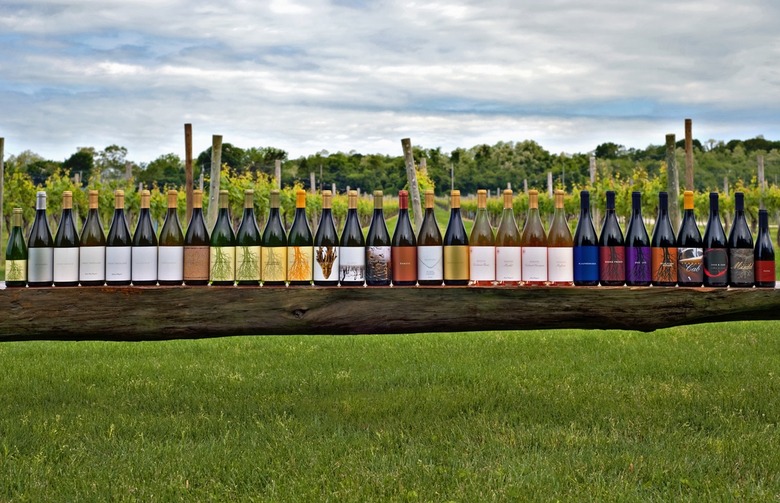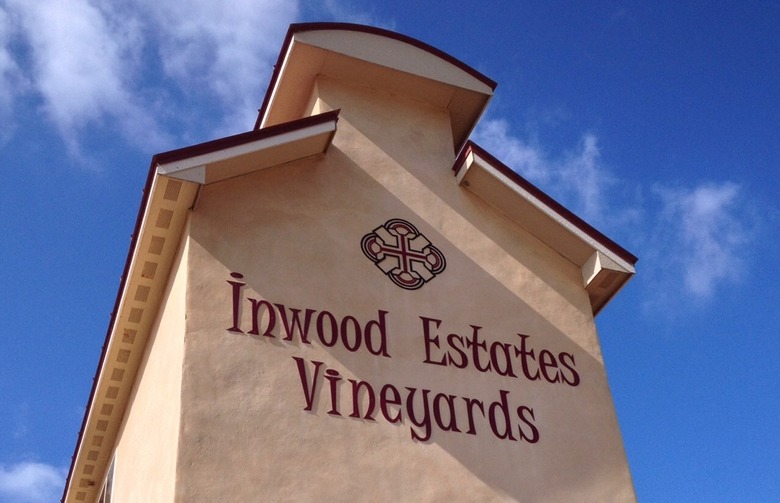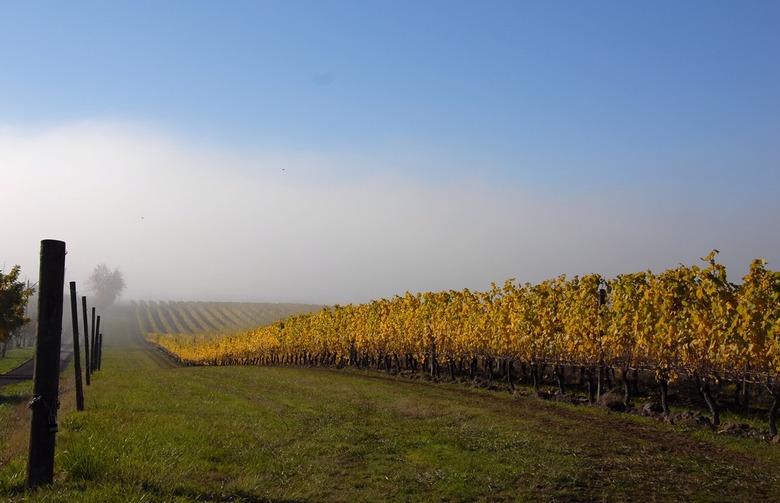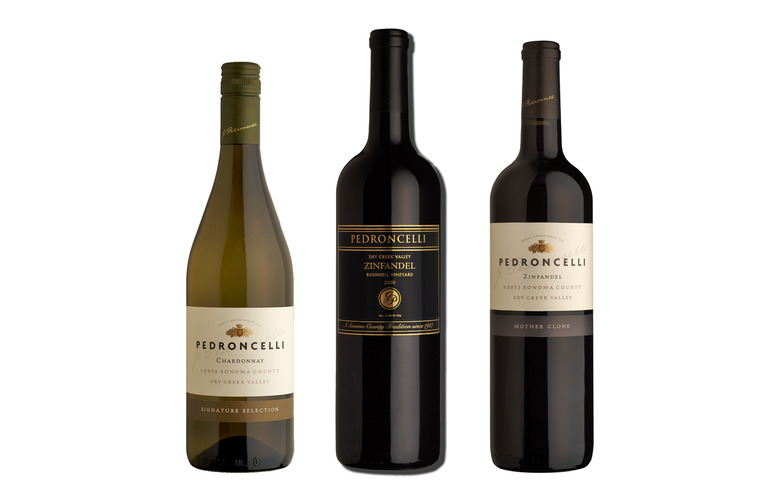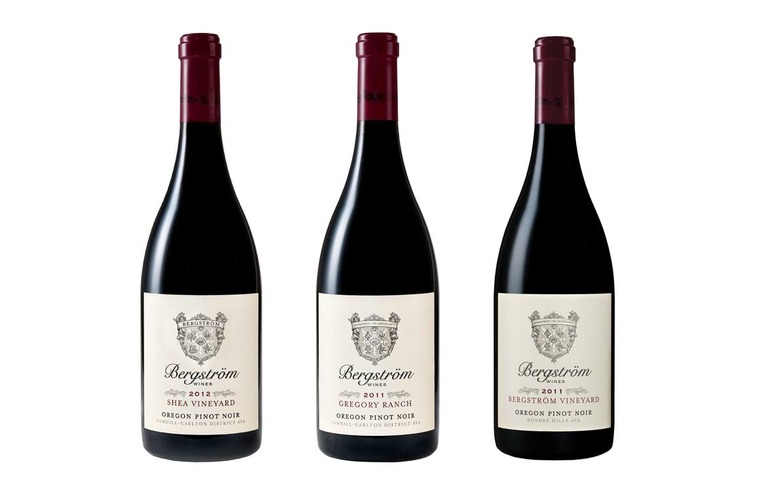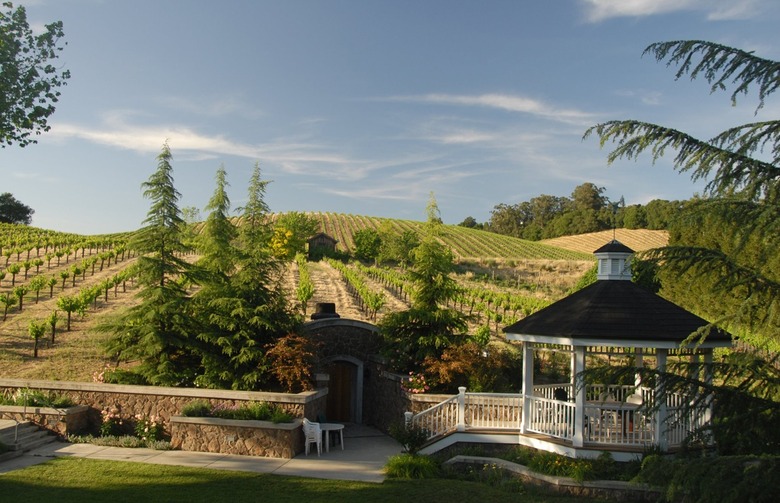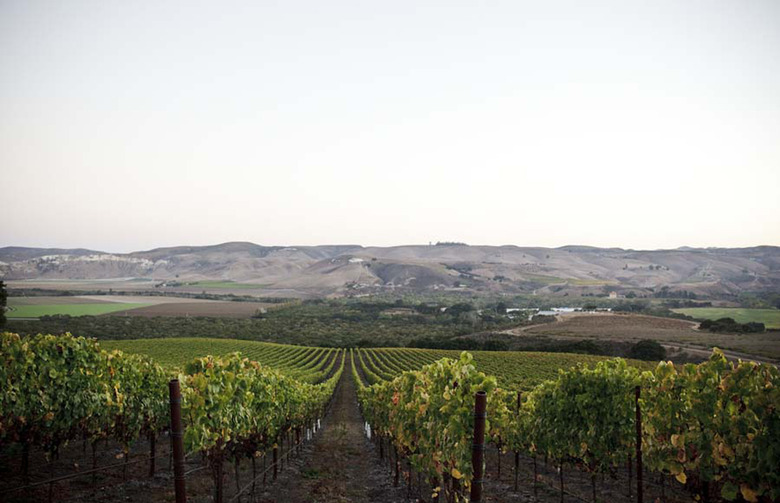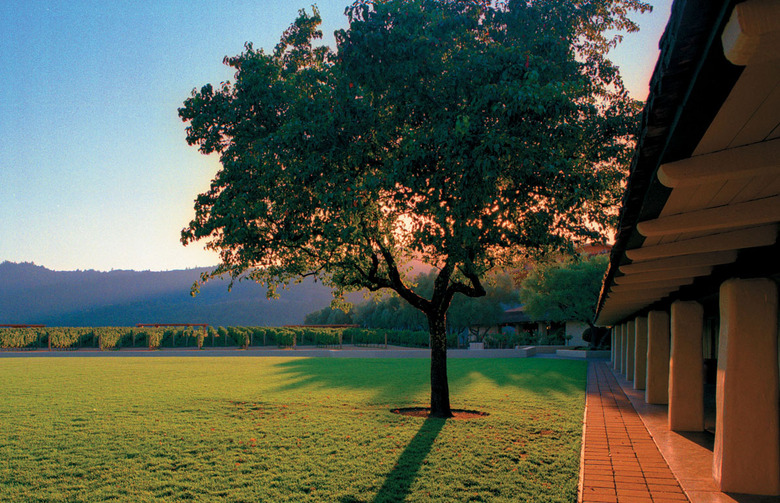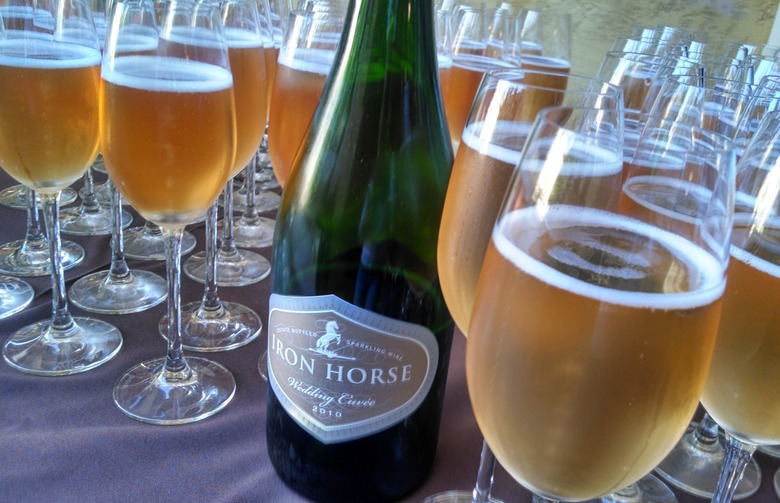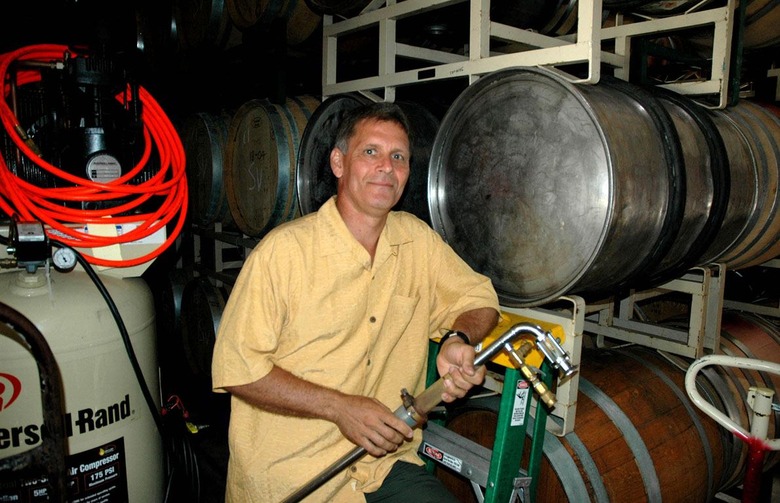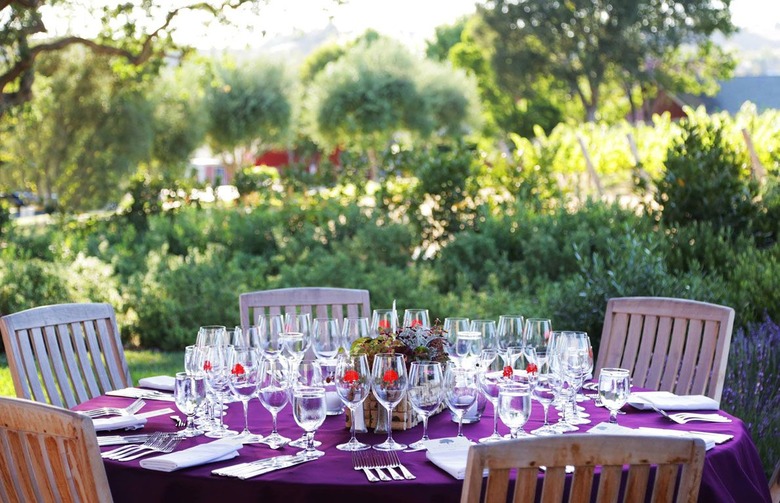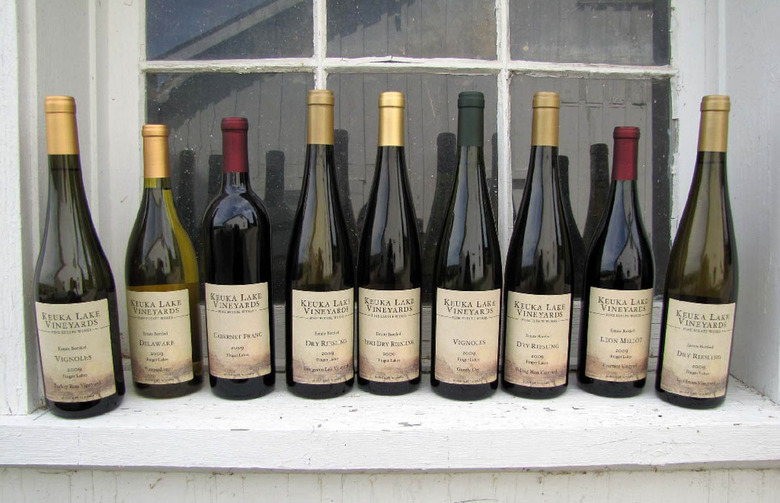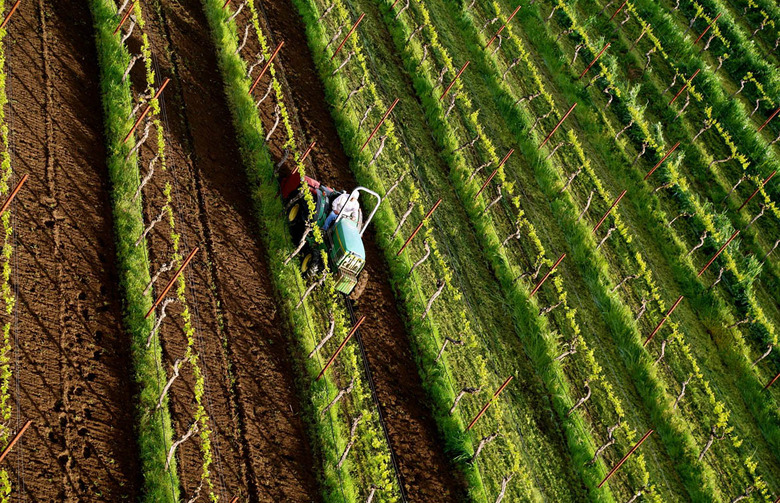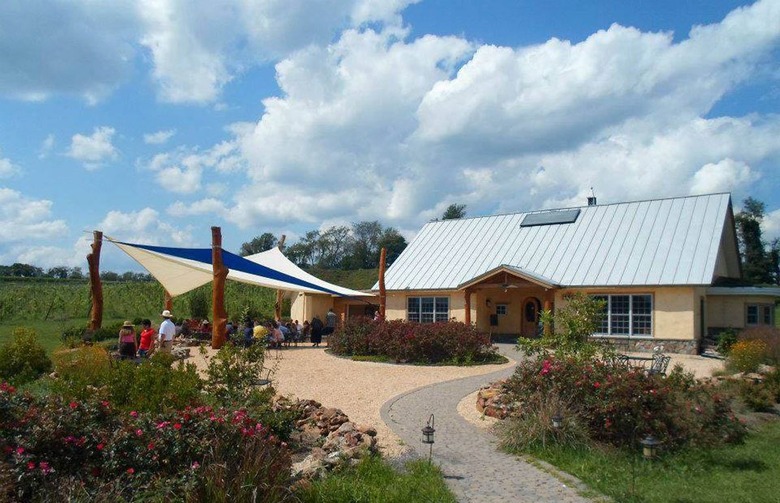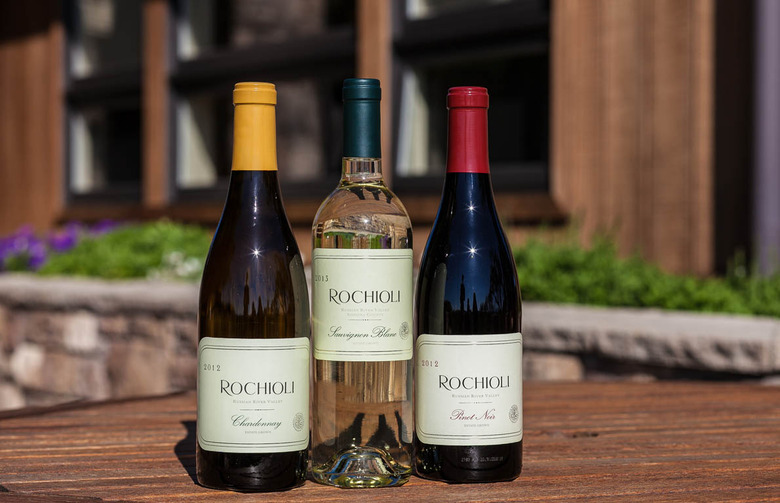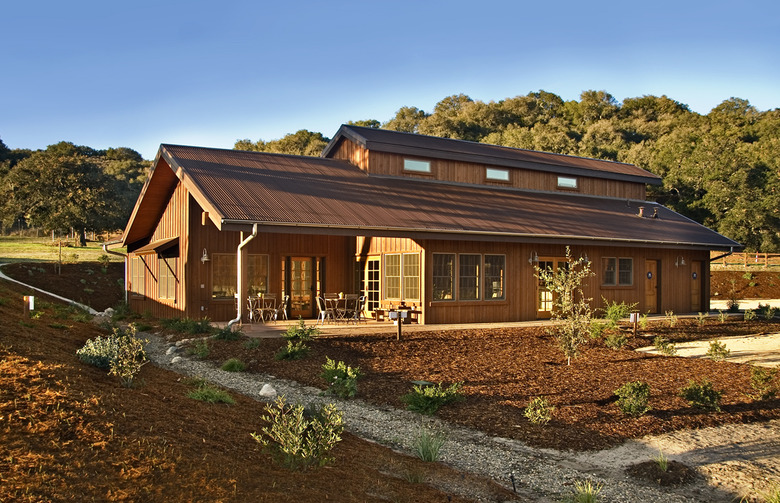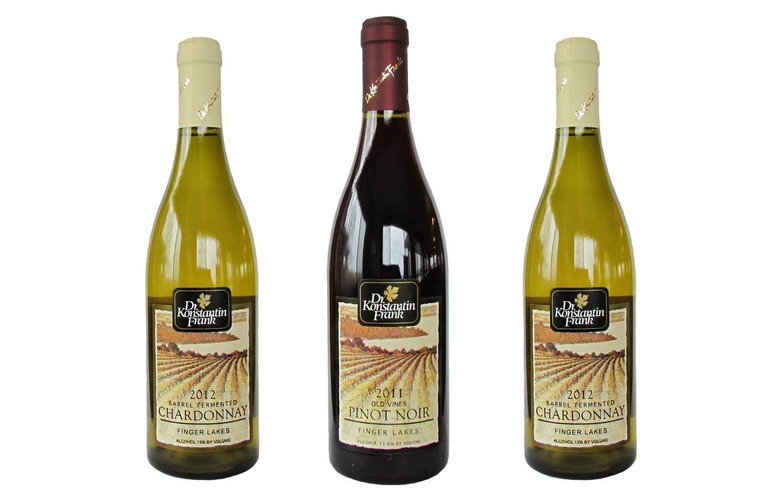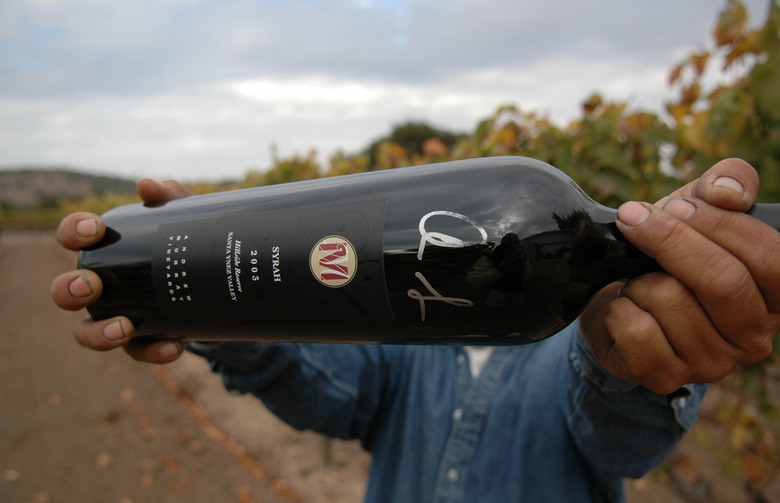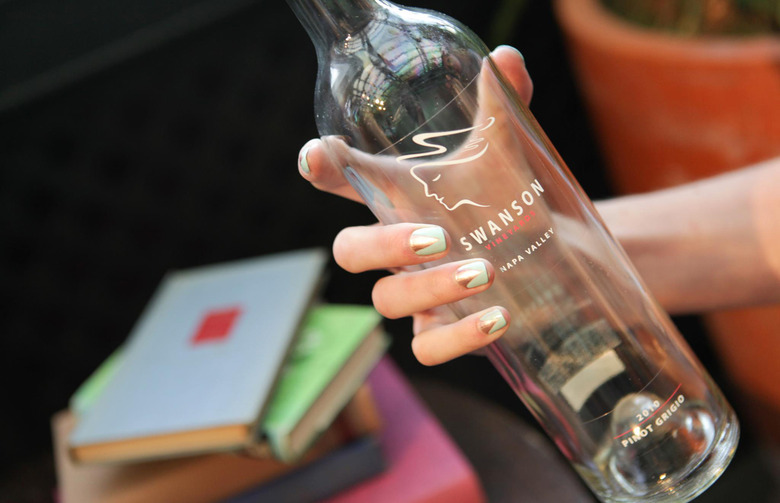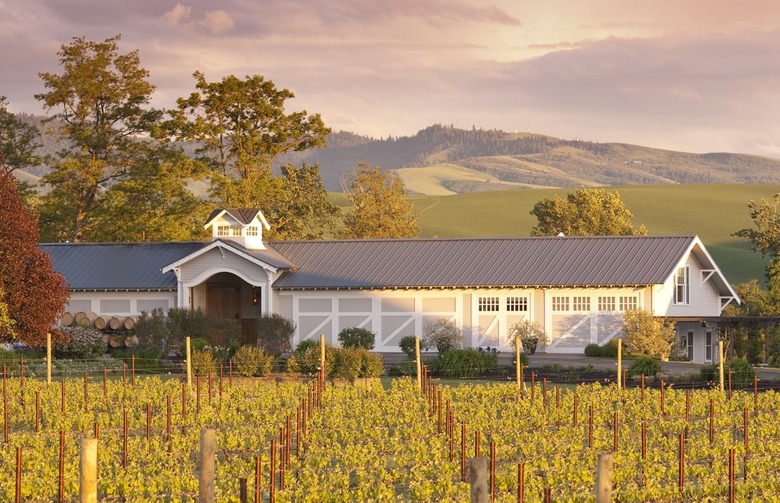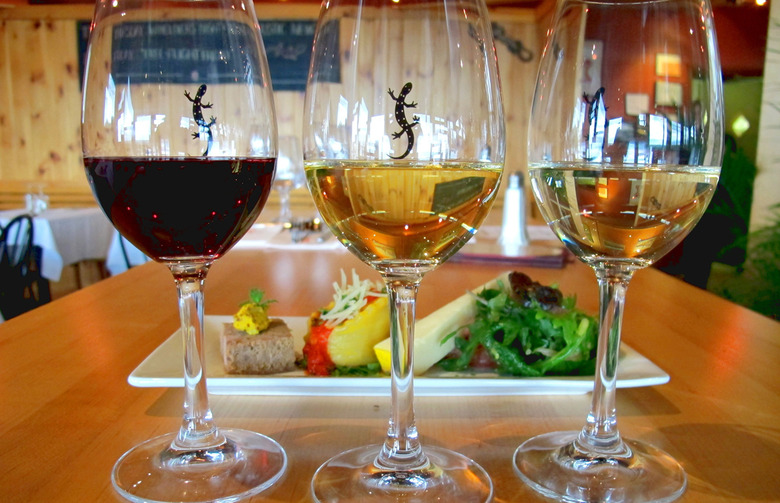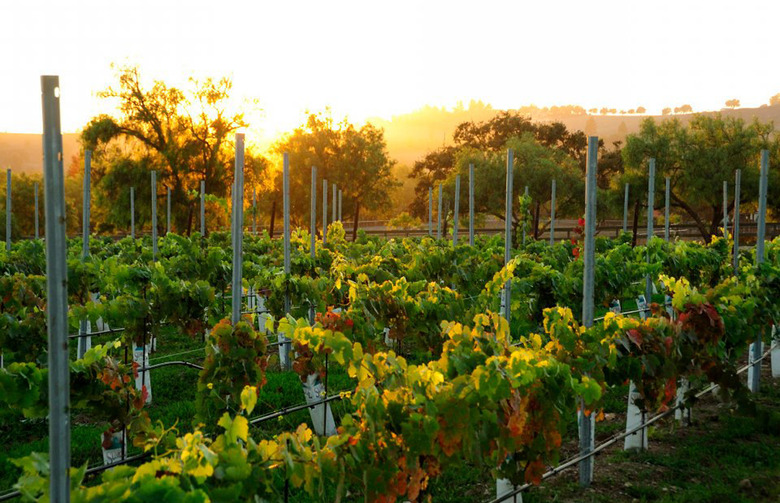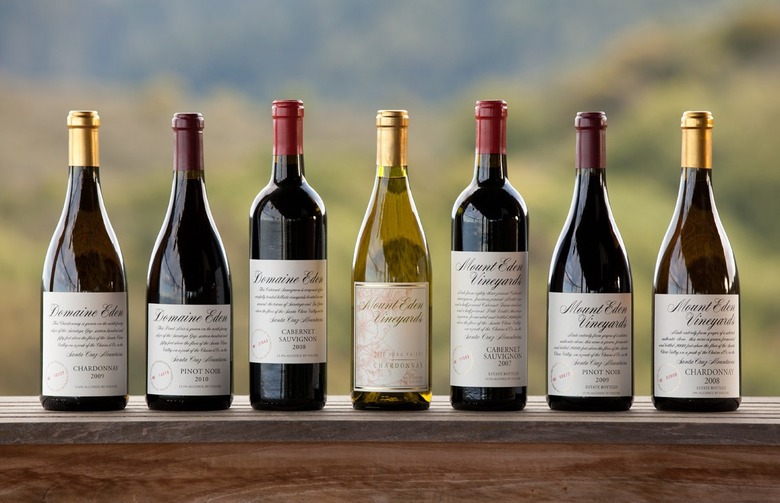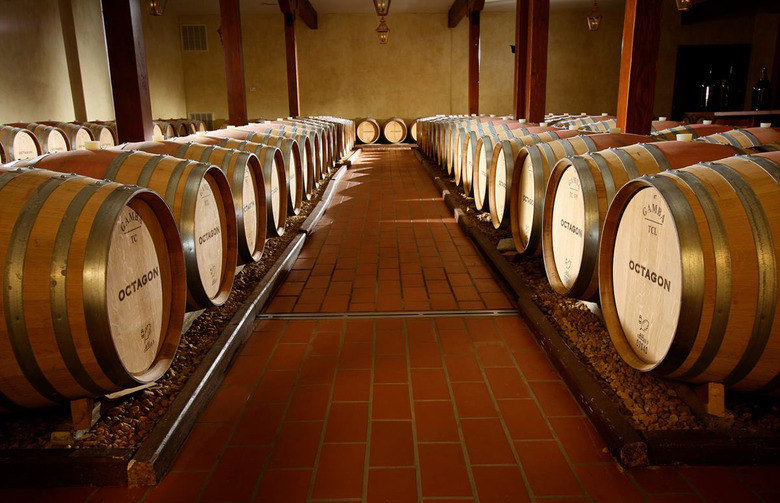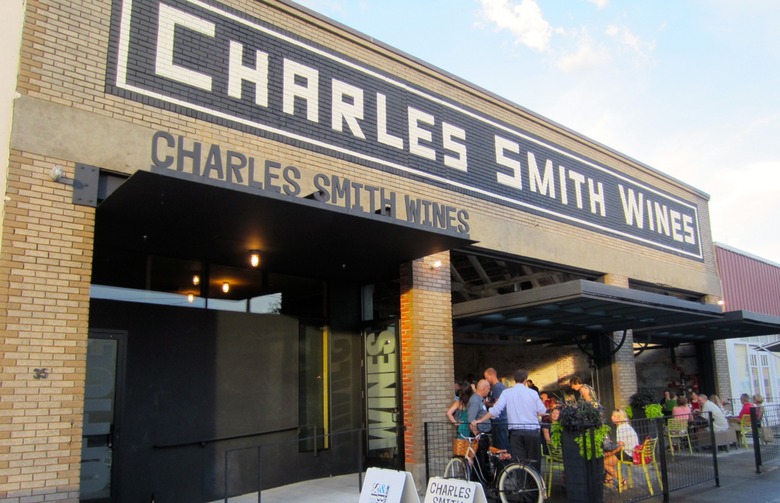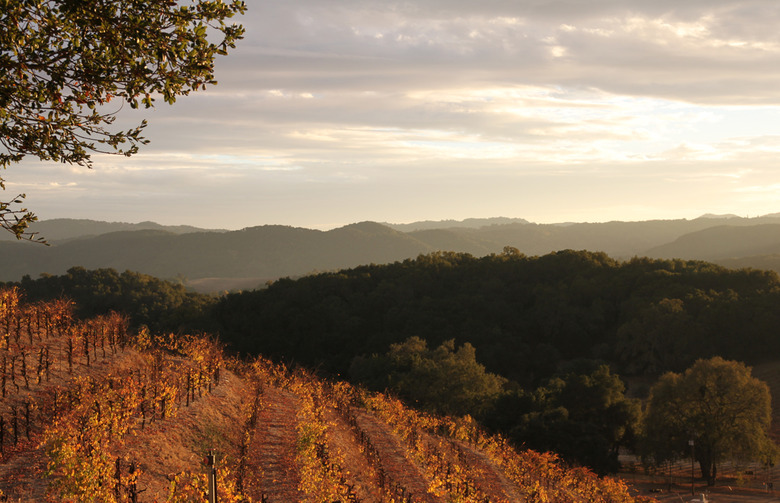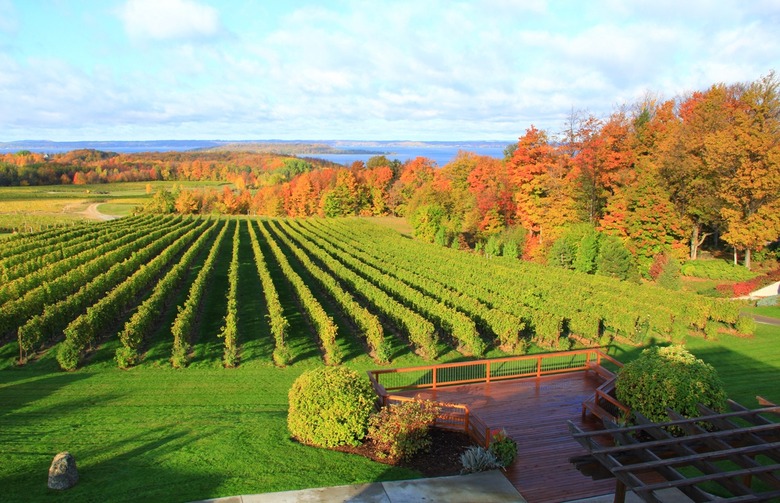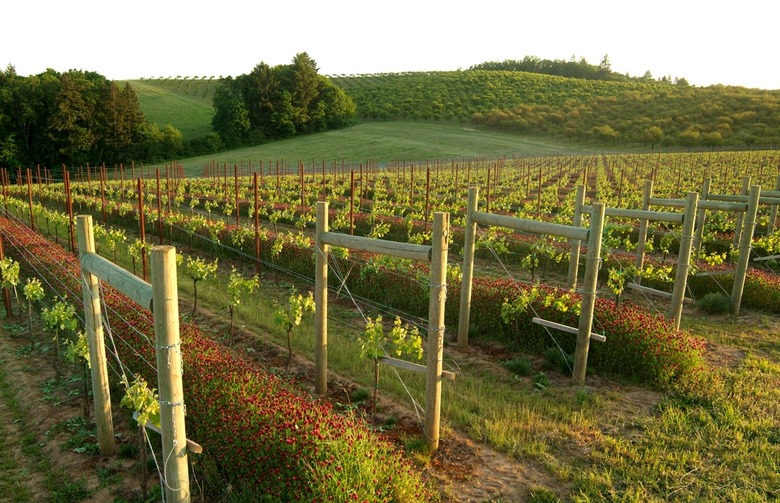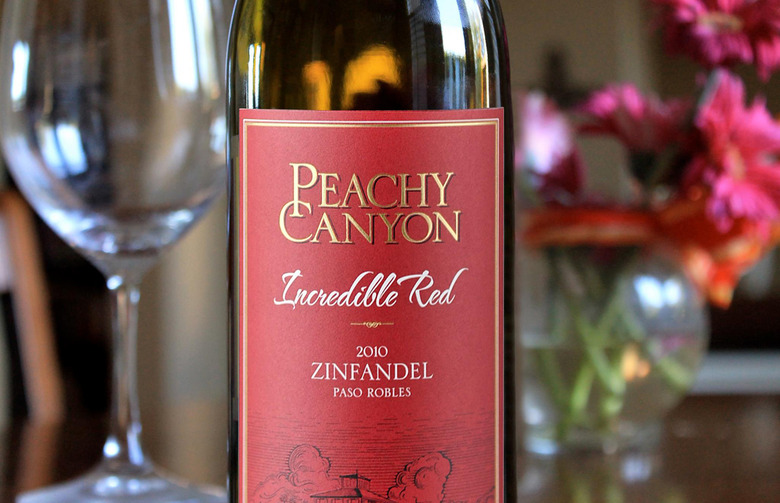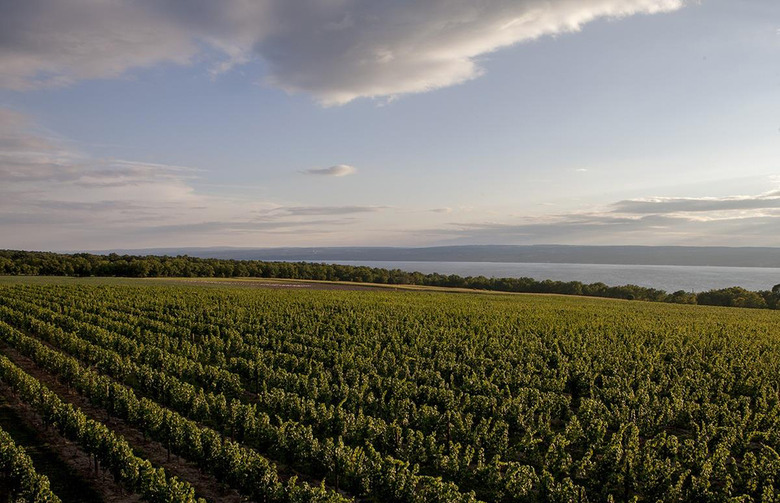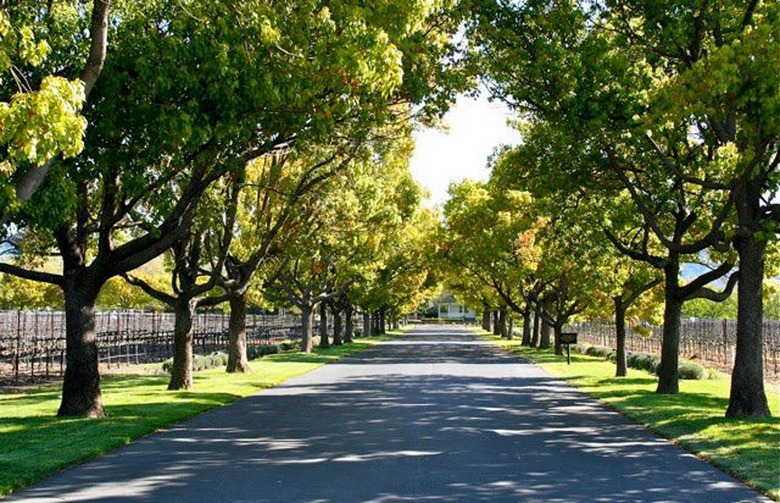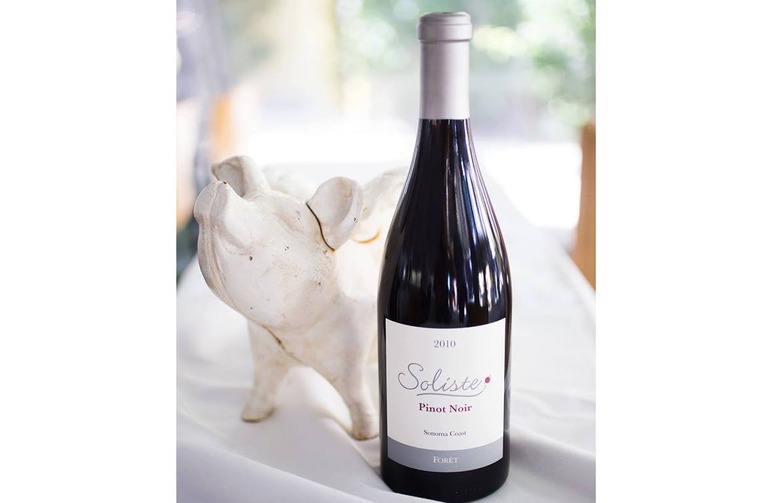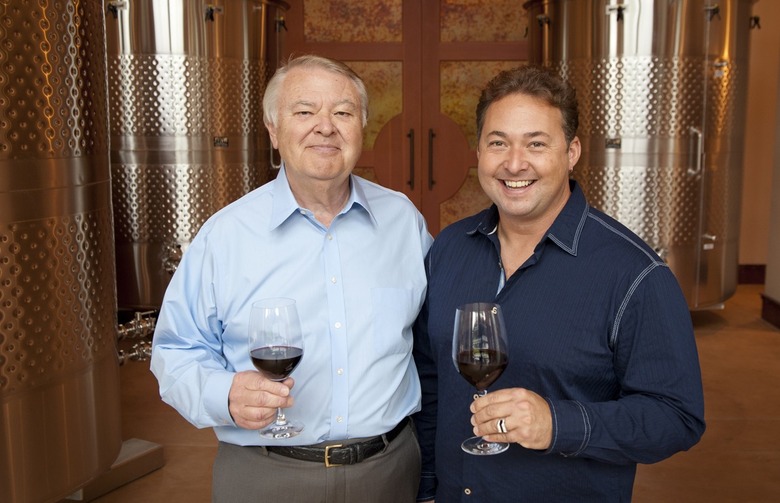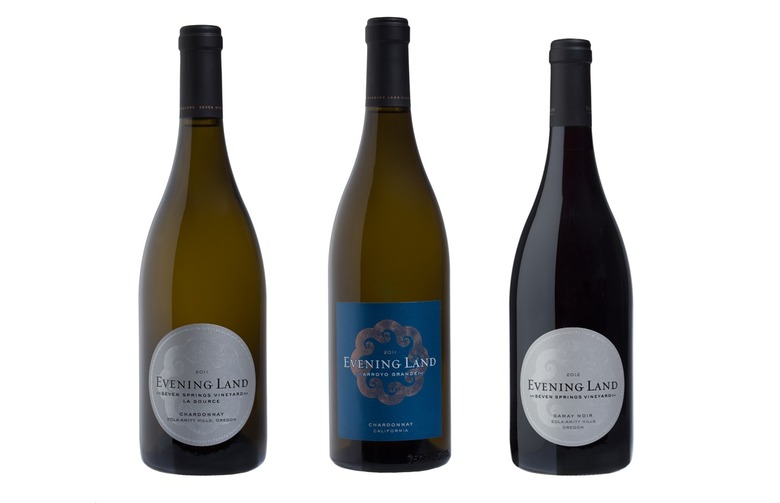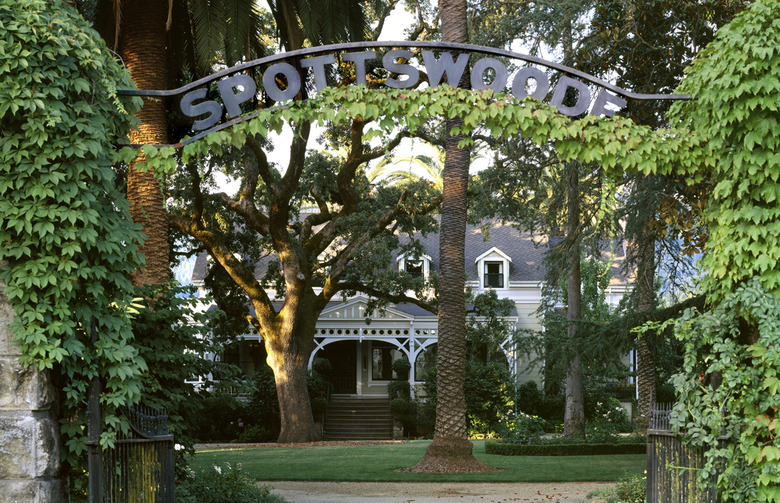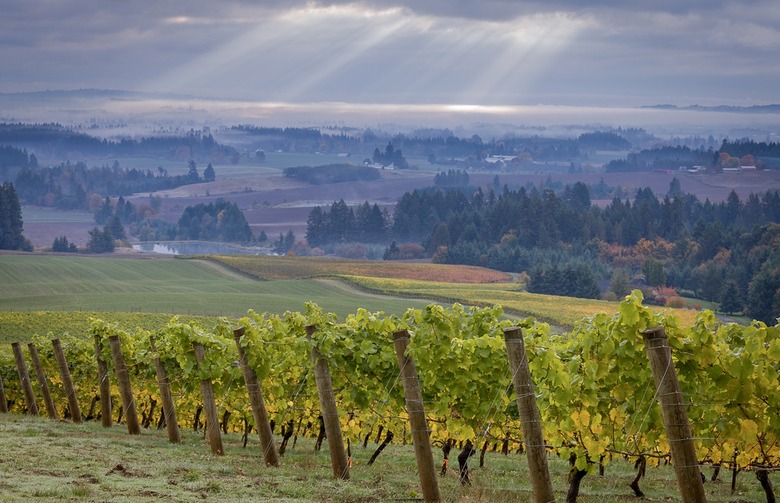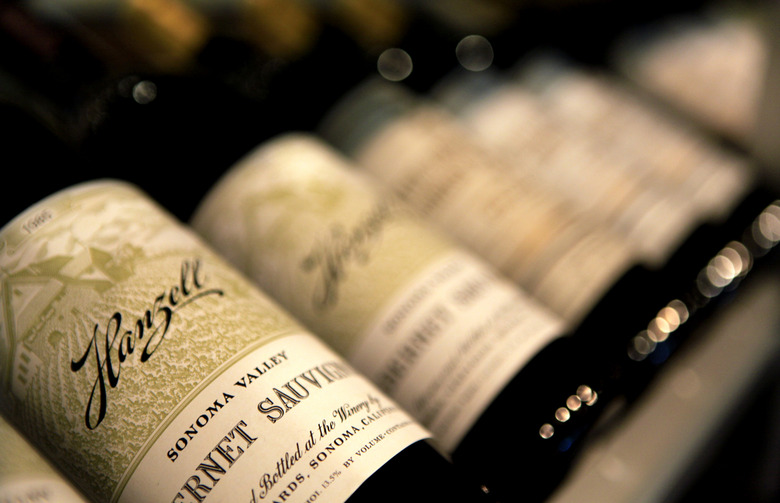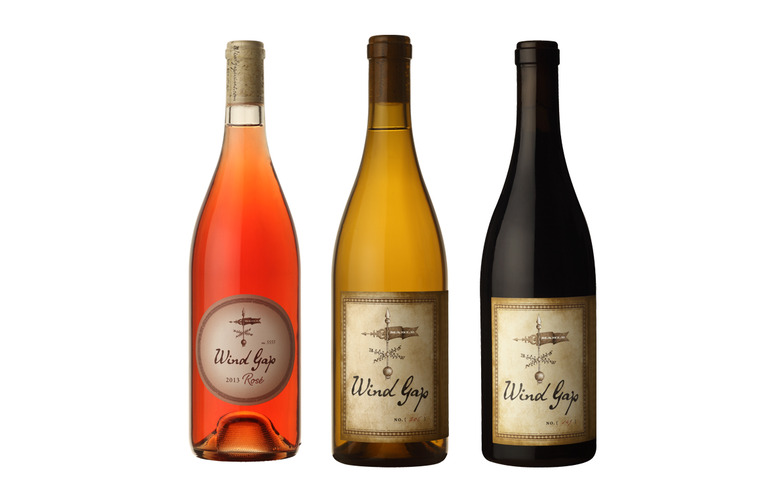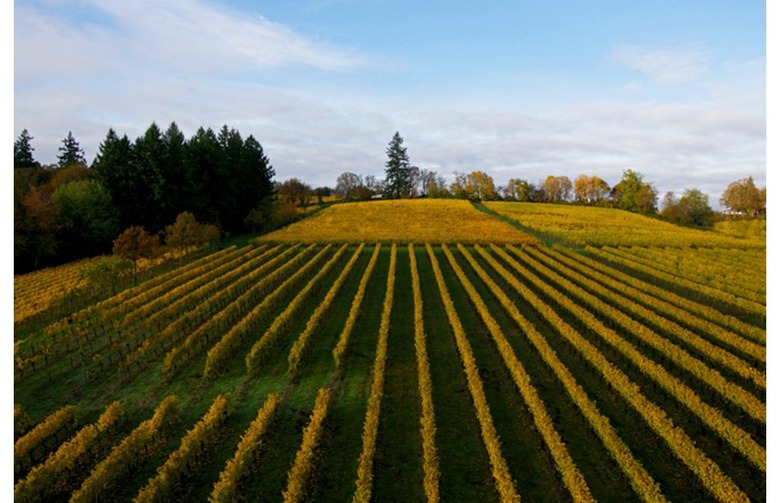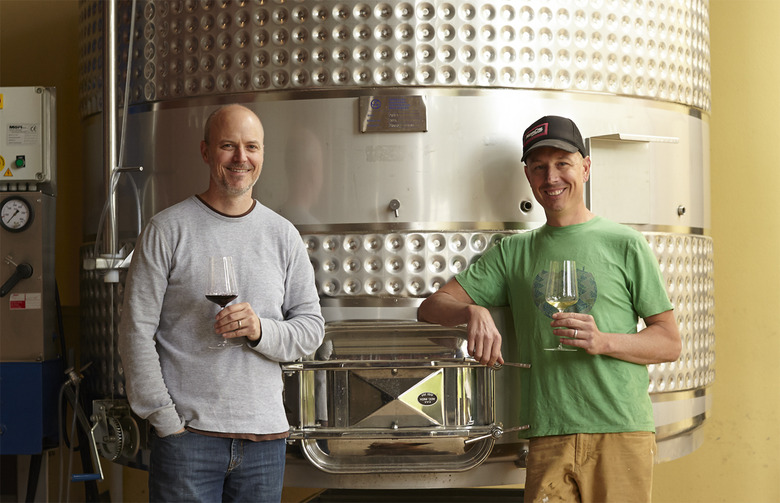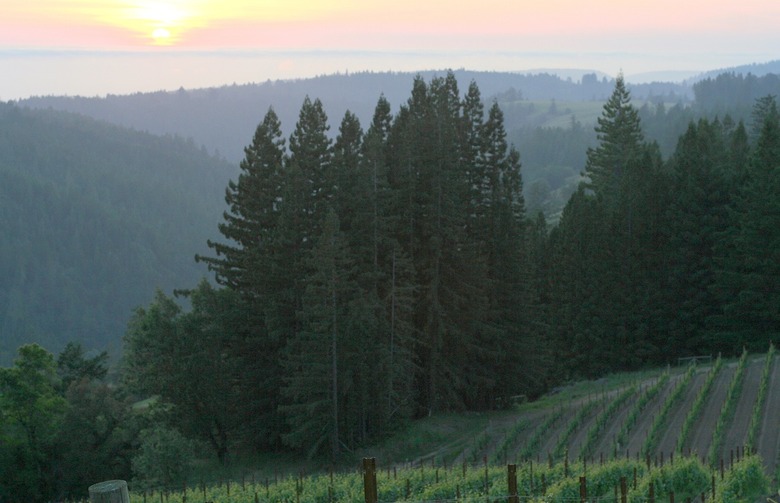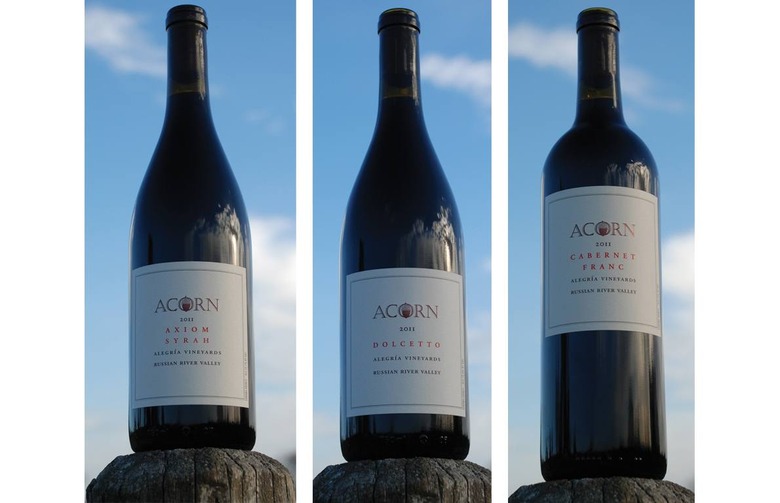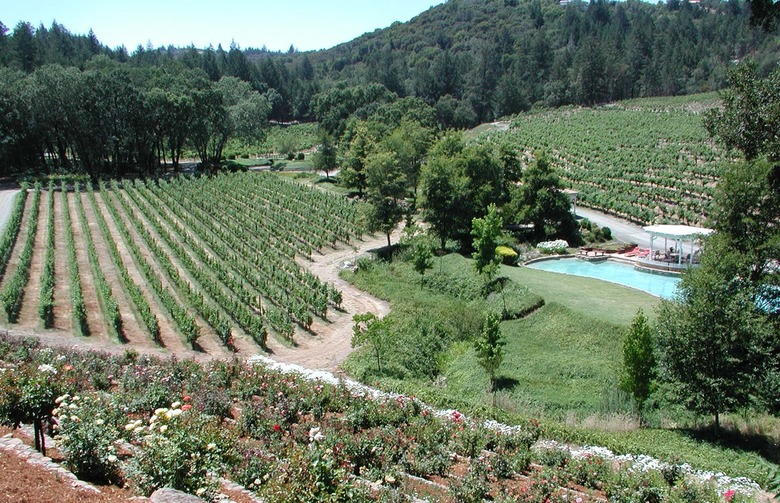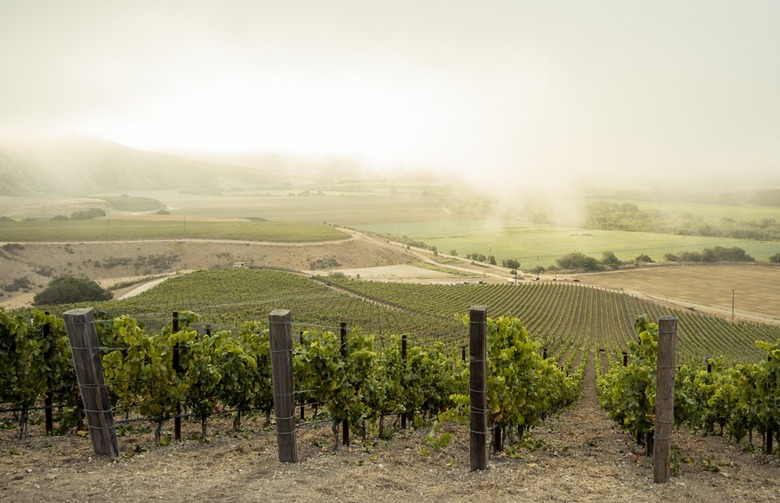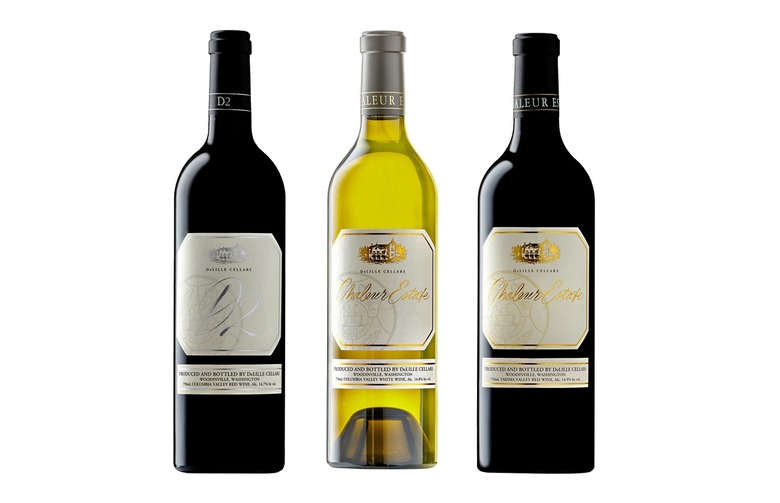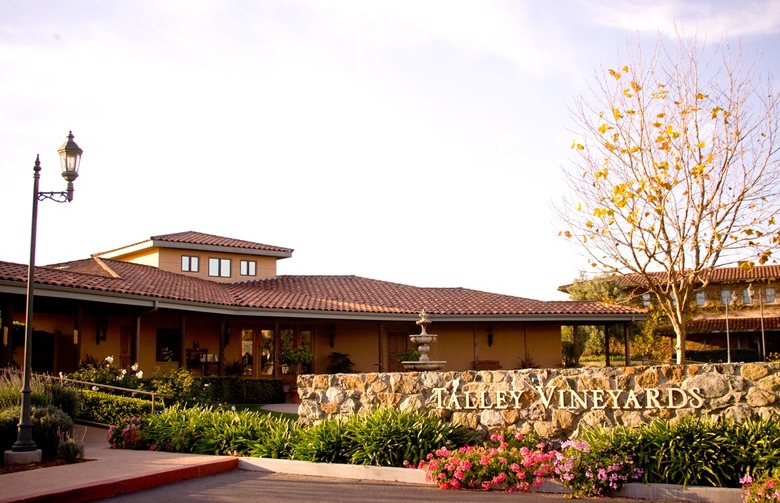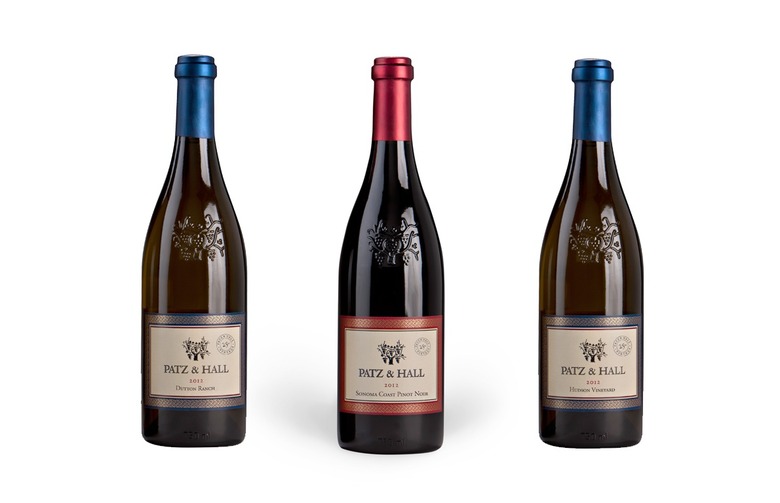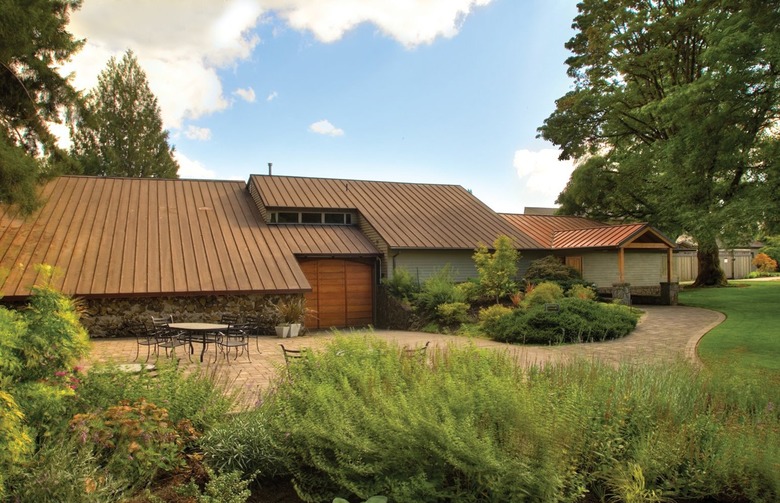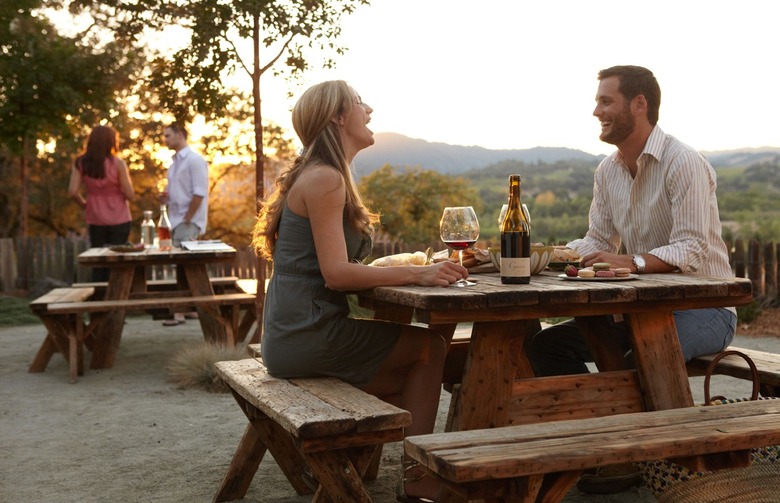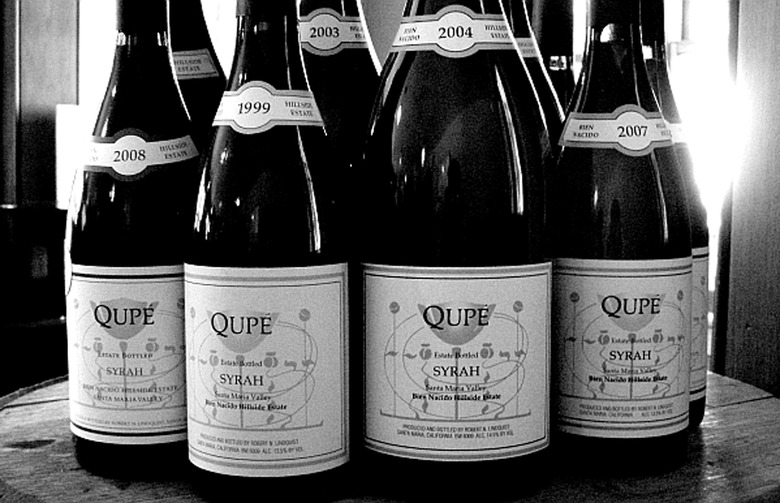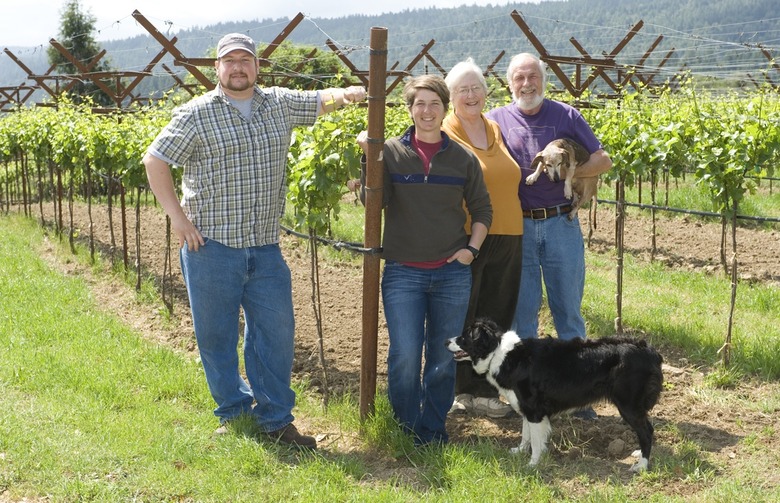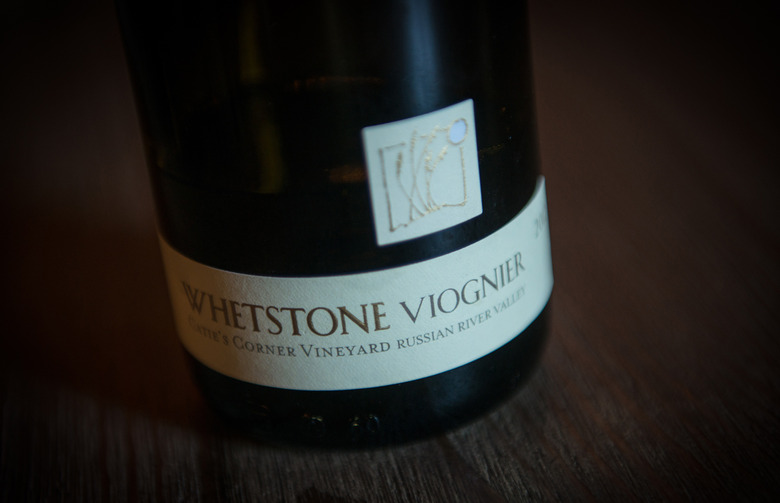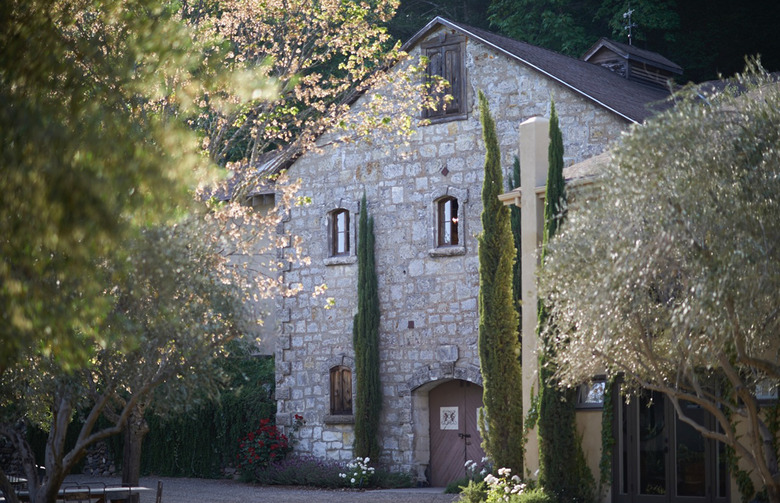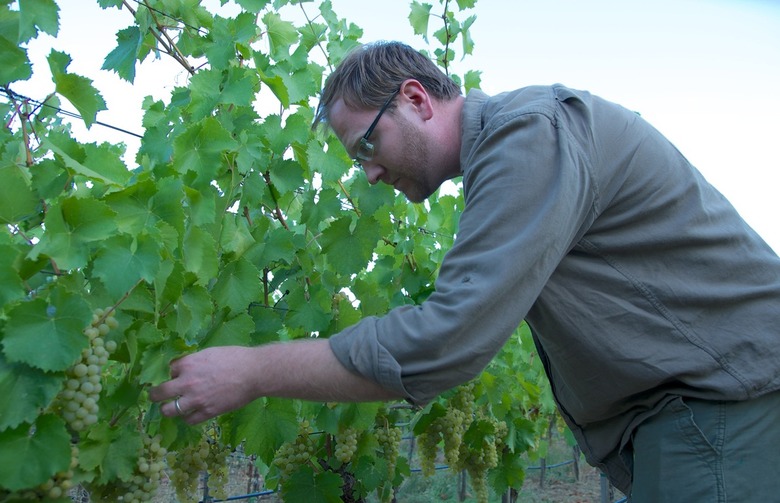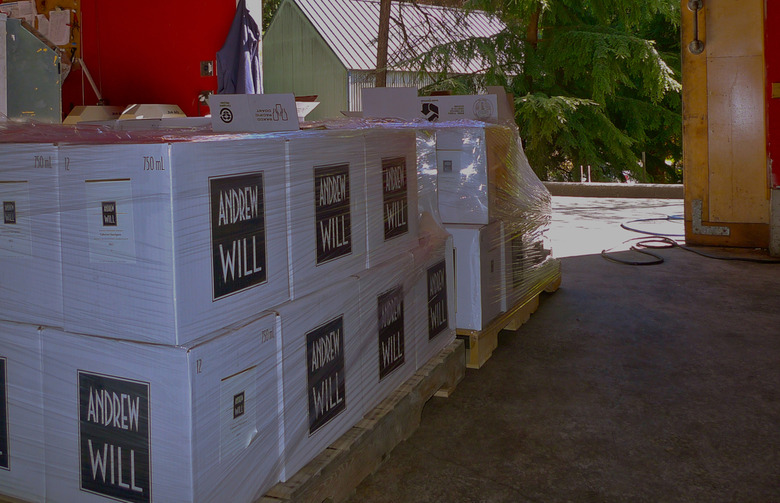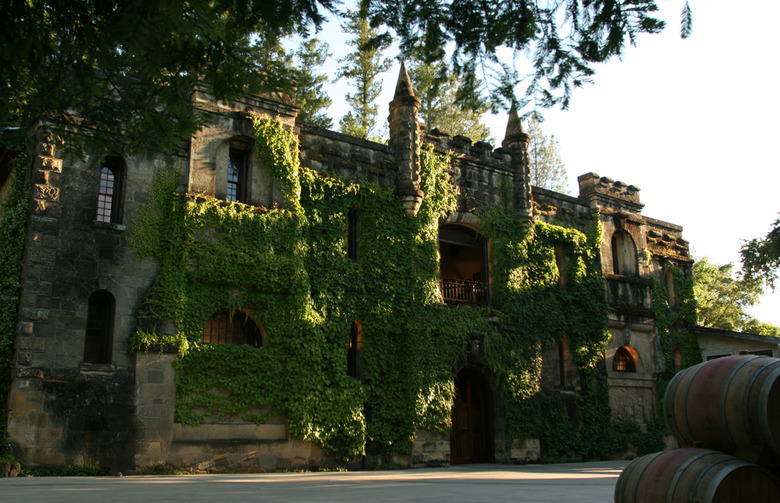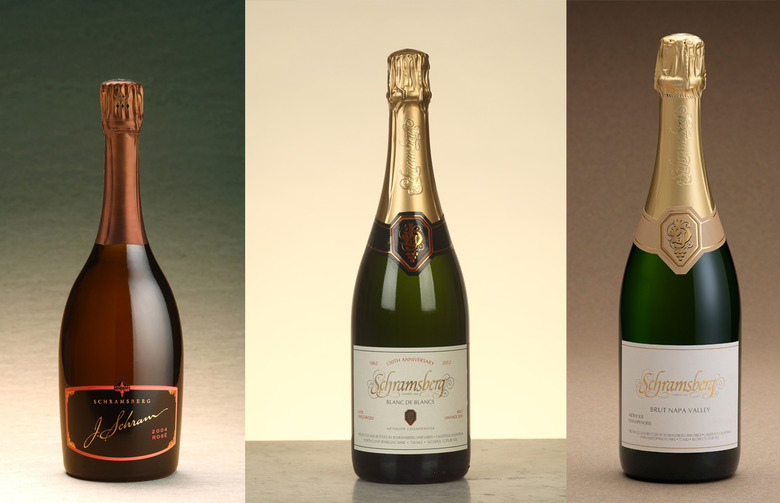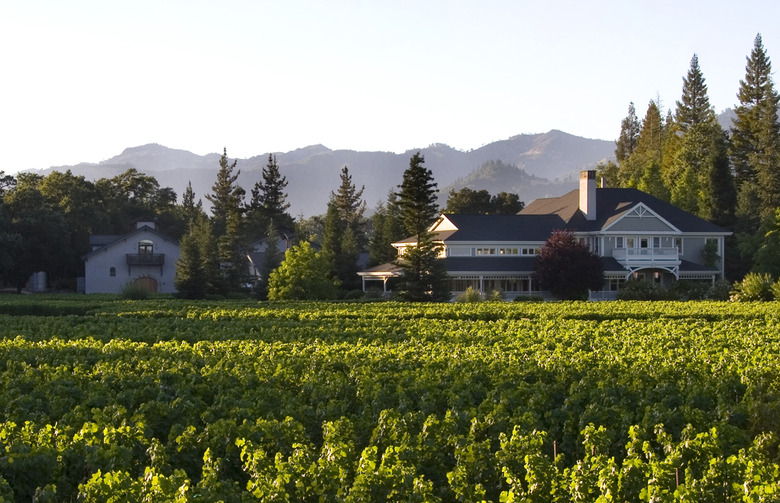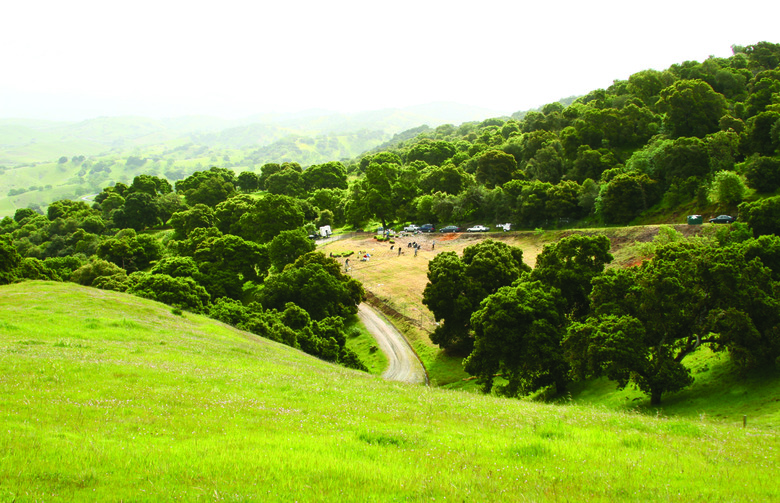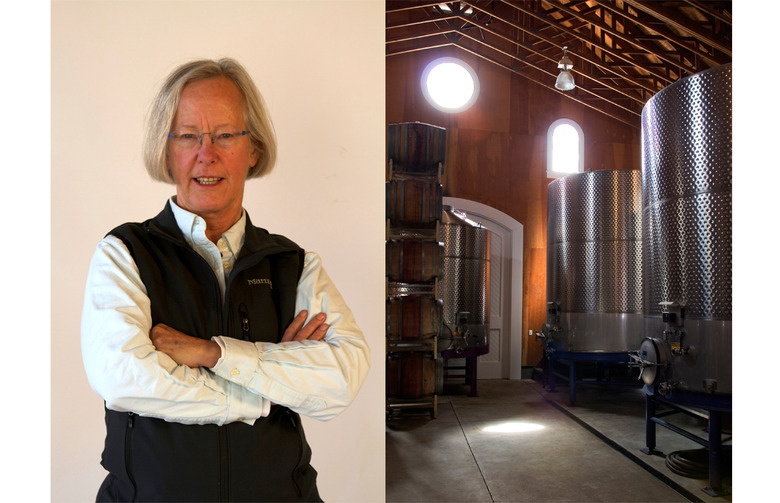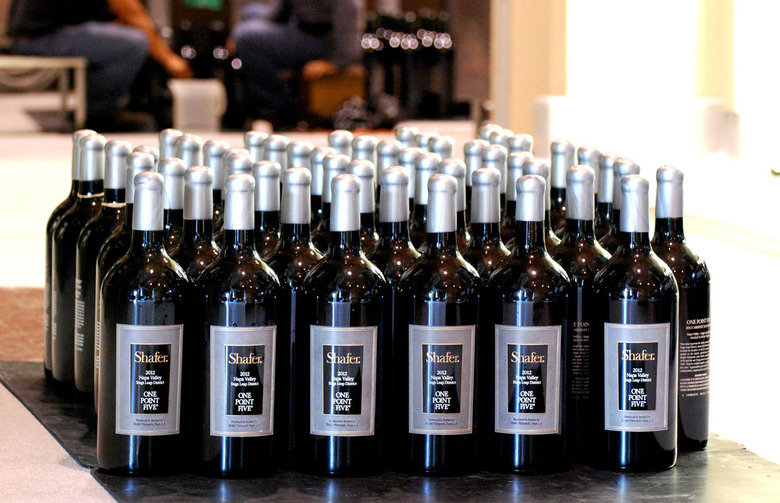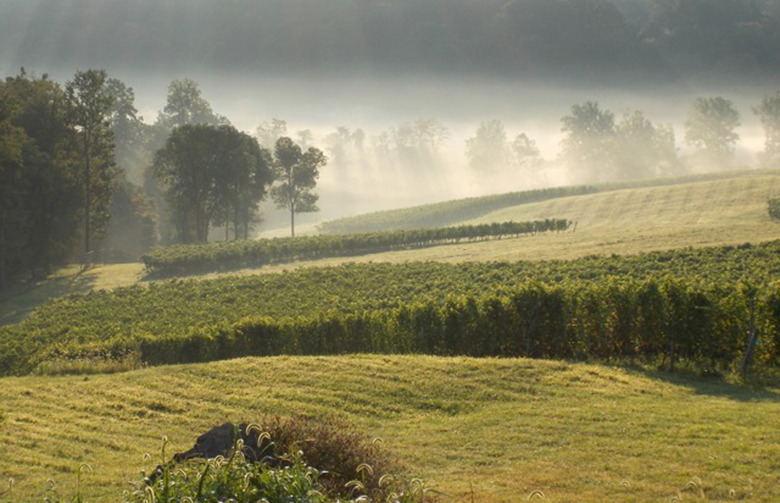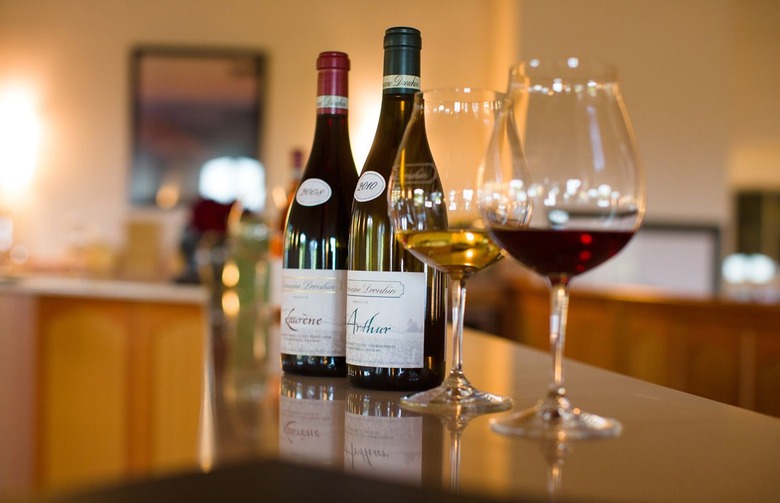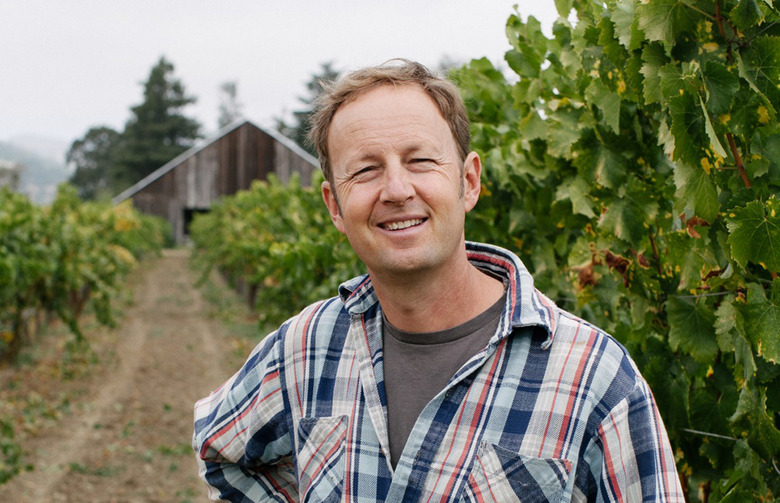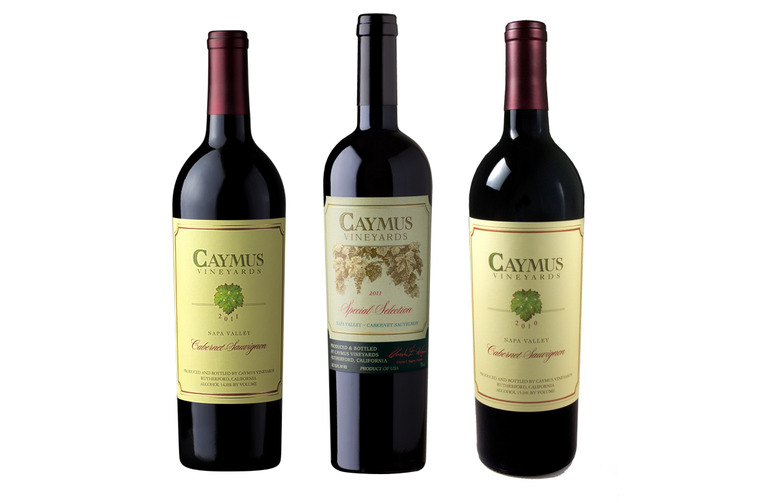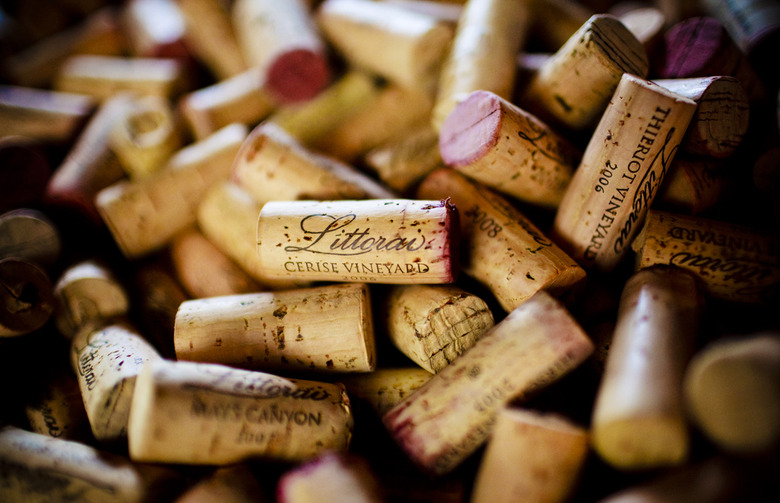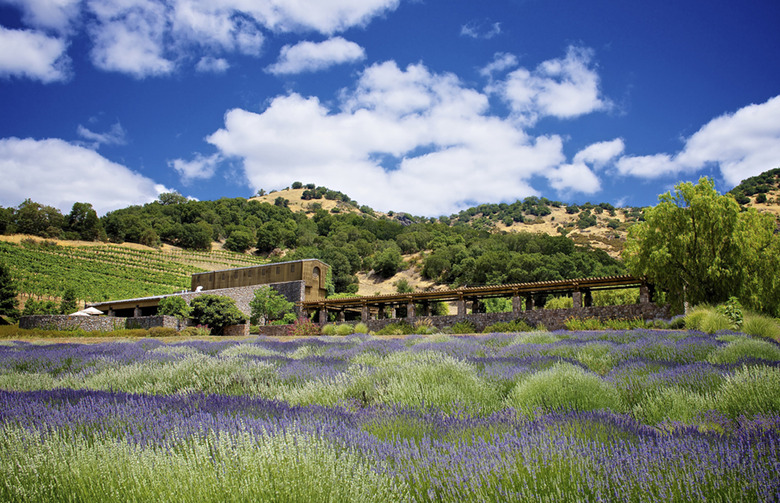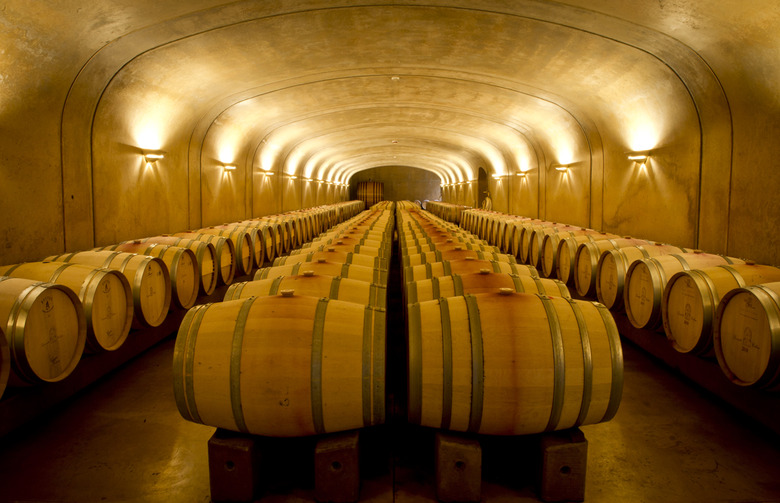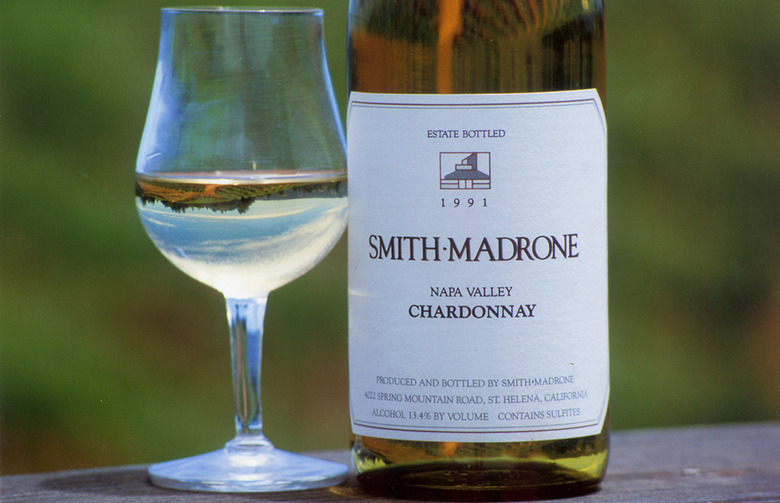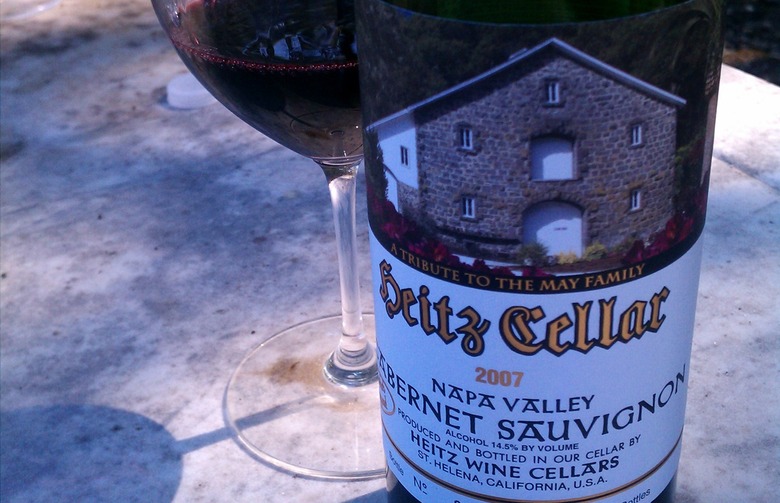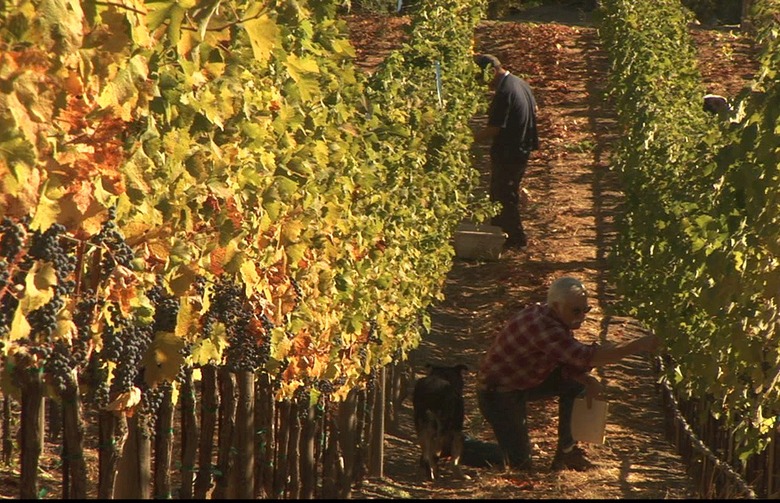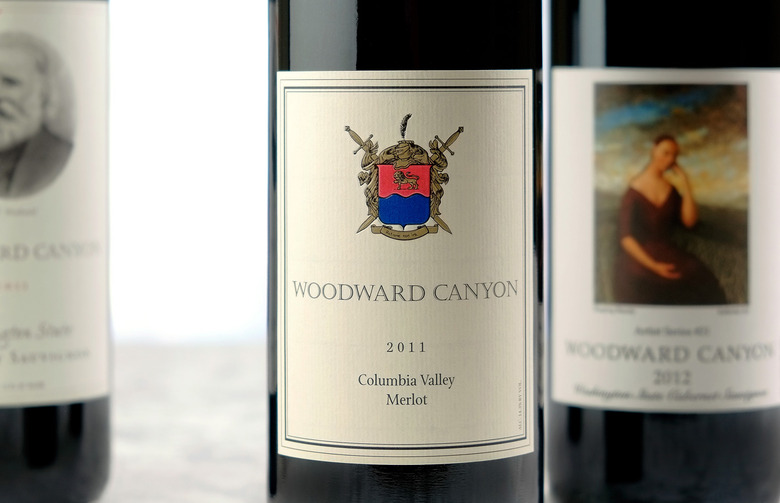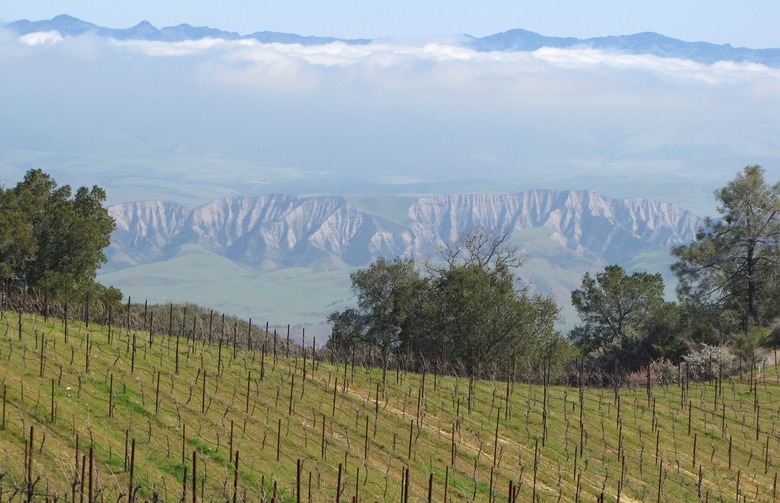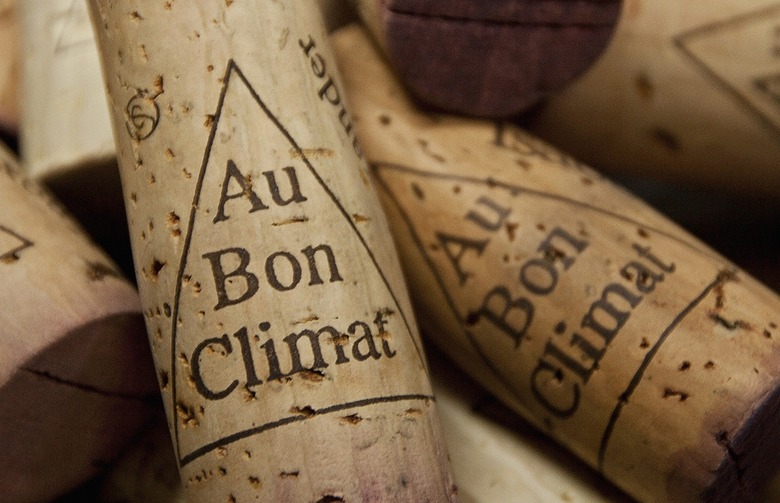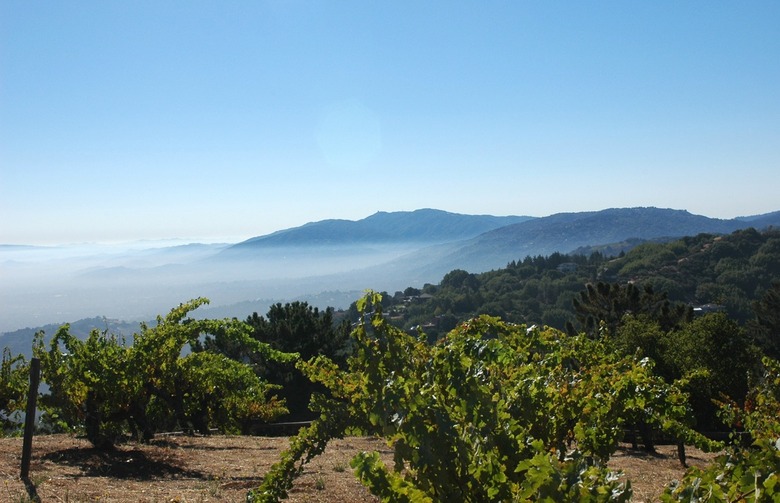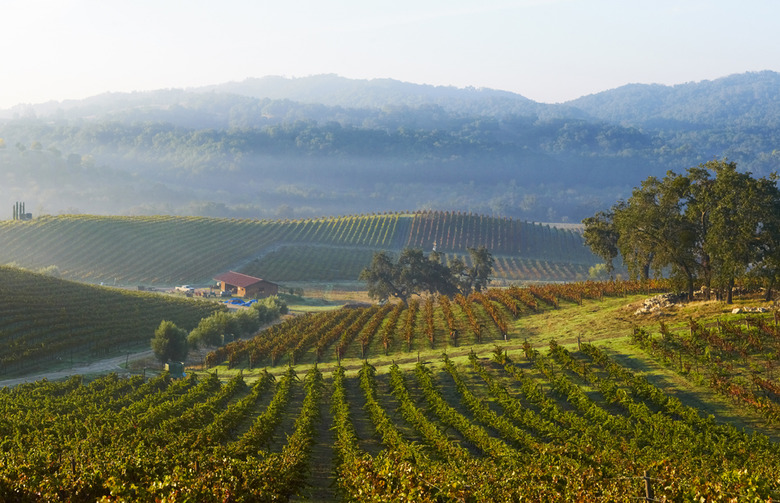101 Best Wineries In America Slideshow
We're proud of the following list, and grateful to the experts who helped us compile it. We're also excited to hear your feedback: Did your favorite American winery make the cut? Let us know which winery on our list is your favorite — or if we missed one that you love — by tweeting us @TheDailyMeal using the hashtag #101BestWineries.
#101 Trione Vineyards and Winery, Geyserville, Calif.
The Trione family have long been grape growers in Sonoma County, but about a dozen years ago they hired winemaker Scot Covington, who had learned his craft under two legendary California winemakers, Merry Edwards and Bill Bonetti, and started their own winery. Covington chooses his grapes from the hundreds of acres of the Triones' farm in the Alexander and Russian River valleys (what he doesn't want is sold to other producers). The Trione portfolio (sauvignon blanc, chardonnay, pinot noir, syrah, and cabernet sauvignon) is outstanding, says wine writer and blogger Gabe Sasso, "deep on quality, breadth of flavors, and plain old deliciousness." Trione may be a young winery, but Sasso says it's "an up-and-coming powerhouse to keep an eye on."
#100 Dolin Malibu Estate Vineyards, Malibu, Calif.
Last summer, the U.S. Alcohol and Tobacco Tax and Trade Bureau awarded AVA, or American Viticultural Area, status to the region called Malibu Coast, which extends up from the coastline high into the Santa Monica Mountains. Elliott Dolin was one of the leaders of the movement to recognize the area, which now boasts more than 50 mostly small-scale producers. (There's even an annual Malibu Food and Wine Festival.) A onetime musician turned real estate investor, Dolin makes juicy, earthy pinot noirs from Central Coast grapes, but his masterpiece is his estate-grown chardonnay, full of fruit and only lightly touched with oak. Dolin's production is tiny, but he's a serious winemaker, and a poster boy for the possibilities of this corner of California, where the first grapes were planted in the early 1800s.
#99 Hope Family Wines, Paso Robles, Calif.
Liberty School was launched by Charlie Wagner of the Napa Valley's Caymus Vineyards (see No. 12) and eventually encompassed grapes not just from Napa but from the Central Coast (and even Chile, another story). The Hope family was among the growers Caymus bought from, and in 1996 they took over the label. Liberty School joined a group of labels that now includes the popular-priced Candor and Troublemaker and the more premium Austin Hope and Treana, the former specializing in intensely flavored Rhône-style wines (their roussanne is particularly successful), the latter in chardonnay, a viognier–marsanne blend, and a flagship red that combines syrah and cabernet sauvignon to memorable effect.
#98 Ste. Chapelle Winery, Caldwell, Idaho
Oregon and Washington get all the attention in wine circles (quite rightly), but their neighbor to the east now boasts more than 50 wineries of its own — the largest and probably oldest of which is Ste. Chapelle. Its catalogue includes a wide range of agreeable everyday wines (riesling, sauvignon blanc, petit verdot, cabernet sauvignon, etc.) at $10 to $12, but soars onto this list with its absolutely charming Panoramic Grenache and its single-vineyard chardonnays, bright and full of varietal character.
#97 Broc Cellars, Berkeley, Calif.
At Broc, says Keith Beavers, wine writer and proprietor of New York City's In Vino wine bar, "Young California winemaker Chris Brockway is helping to define what is being called 'New California' wine. He plays around with all kinds of grapes, including the Languedoc native picpoul. He farms in the most natural way possible, coaxing wine out of low-energy facilities for the 'green' factor." Brockway would also seem to have a subtle sense of humor, releasing a "white zinfandel" that is actually an excellent, bone-dry zinfandel rosé, guaranteed to disappoint anyone expecting one of those dull, sweet white zins that were once all too popular.
#96 Cornerstone Cellars, Yountville, Calif., and Gaston, Ore.
Michael Dragutsky and Craig Camp of Cornerstone Cellars believe that there is no better place in the world to grow cabernet sauvignon, cabernet franc, and merlot than the Napa Valley, but that Oregon's Willamette Valley produces better chardonnay and pinot noir than Napa can — so they make wine in both places. (They also produce, among other wines, a Napa Valley syrah rosé called Corallina that has been widely hailed.) Whichever state they're from, Cornerstone's offerings are forthright and rich — not wines that will sit quietly in the corner.
#95 Gruet Winery, Albuquerque, N.M.
The Gruet family had already been producing Champagne in Bethon, near Épernay, for 30 years when they first visited the American Southwest in the 1980s. To their surprise, they discovered chardonnay and pinot noir vines being cultivated successfully at high altitudes about 150 miles south of Albuquerque. They planted their own vines and began making sparkling wines in the classic méthode traditionelle, relying on the low humidity to prevent rot, and the cool nights at 4,300 feet above sea level to slow-ripen the grapes for greatest complexity. The results have been wonderful. Today, Gruet produces a range of both vintage and non-vintage sparklers, including an ethereal rosé, fairly priced and extremely reminiscent of wines made back home in the Champagne region.
#94 MacPhail Family Wines, Healdsburg, Calif.
Wine writer and blogger Gabe Sasso salutes James MacPhail and his winery for "doing a remarkable job with site-specific pinot noirs from numerous regions in California." He adds, "By producing single-vineyard wines as well as cuvée-style offerings, he's showing many different sides and characteristics of this beloved grape." For pinot noir lovers, MacPhail's wines are a must.
#93 Shinn Estate Vineyards and Farmhouse, Mattituck, N.Y.
Vineyard manager Barbara Shinn and winemaker David Page are pioneers of biodynamic viticulture at their winery on Long Island's North Fork (among other things, their property is solar- and wind-powered). "The wines they produce," says Keith Beavers, wine writer and proprietor of New York City's In Vino wine bar, "are a very true expression of what Long Island terroir has to offer." These wines — which include sauvignon blanc, chardonnay, pinot blanc, merlot, and the region's signature grape, cabernet franc — Beavers continues, "have structure and soul" that balance out their high-tone elegance.
#92 Bokisch Vineyards, Lodi, Calif.
Markus and Liz Bokisch have translated their passion for Spanish wines — he spent his childhood summers in Spain and the two of them later worked for wineries in Catalonia's Penedès region — to their winery in California's Central Valley. Their wines, all certified "green" by the Lodi Rules for Sustainable Winegrowing program, include vivid interpretations of albariño, verdejo, verdelho, garnacha blanca, garnacha, tempranillo, monastrell, and graciano (a comparatively minor but important red Rioja variety) — the 2012 iteration of which won a double gold at the California State Fair Wine Competition. With a new enterprise, Tizona Wines, the Bokisches are beginning to work with zinfandel and malbec, and promise "perhaps a sherry or even a cava at some point in the future."
#91 Allis Ranch Winery, Sedalia, Colo.
Colorado is hardly the first state people associate with wine — especially these days, when it gets so much press for a different intoxicant — but the wine industry here dates back to the nineteenth century and today there are at least 100 Colorado wineries — most of them tiny boutique operations like this one, located on a former cattle ranch. At Allis Ranch, David and Margaret Rhyne produce not much more than 400 cases annually, but their Rhône-style reds, based on roussanne, syrah, and grenache, are astonishing — complex, rich but delicate, full of bright fruit.
#90 Seven Hills Winery, Walla Walla, Wash.
Seven Hills founder Casey McClellan is a fourth-generation farmer whose focus is on vineyard-driven wines. In addition to producing numerous wines from his own Walla Walla property, he buys grapes under long-term contracts from well-regarded vineyards in neighboring areas. In addition to cabernet sauvignons and Bordeaux-style blends of astonishing quality, he sources pinot gris from Oregon and viognier from Washington's Columbia Valley to produce sterling whites.
#89 Frick Winery, Geyserville, Calif.
Bill Frick runs a one-man winery using grapes from his seven-plus-acre vineyard on the hillsides of Sonoma County's Dry Creek Valley. He specializes in Rhône cultivars, releasing varietal carignan, cinsaut, counoise, grenache and grenache blanc, mourvèdre, syrah, and viognier, as well as several white and red blends. His wines, says wine writer and blogger Gabe Sasso, "are loaded with varietal character, proportionate, food friendly, and delicious...[and] also priced extremely well considering the value they represent."
#88 Hermann J. Wiemer Winery, Dundee, N.Y.
Daniel Johannes, corporate wine director for chef Daniel Boulud's Dinex Group, calls this veteran producer "the standard bearer for Finger Lakes riesling." Indeed, Wiemer can be credited at least partially with turning the area into the quality wine region it is today. That the winery's specialty is riesling isn't a surprise, given Wiemer's upbringing in Germany's Moselle riesling country, and the winery's bottlings of the wine — there are eight or nine of them, in various styles and from various vineyards — are consistently among the best in America. Wiemer, though, also essays chardonnay, gewürztraminer, and grüner veltliner successfully, and makes first-rate pinot noir and cabernet franc.
#87 Neyers Vineyards, St. Helena, Calif.
As national sales director for the celebrated Northern California wine importer Kermit Lynch, Bruce Neyers is constantly exposed to some of the best wines of (among other places) Bordeaux, Burgundy, and the Rhône, and he and his young winemaker, Tadeo Borchardt, make finely crafted wines in the traditional French style that play in the same league. Sourcing grapes from Napa (including the Neyers property), Sonoma, and the Central Coast, the winery produces, among other things, award-winning cabernets and chardonnays, elegant pinot noirs, and an unusually complex grenache.
#86 The Ojai Vineyard, Oak View, Calif.
Adam and Helen Tolmach have been making small lots of wine for more than 30 years now, using long-term contracts with growers local to their winery as the foundation of their business. The Tolmachs produce excellent chardonnays as well as some whites based on Rhône varieties, but their strength is in their award-winning syrahs and pinot noirs, sourced from some of the top vineyards around the Central Coast. Their faithful customers join their mailing list to ensure themselves first crack at Ojai's small-lot offerings, but the winery also maintains an unusually large catalogue of library wines for those who prefer their wines more fully developed.
#85 Va La Vineyards, Avondale, Pa.
Anthony Vietri is one of the more original winemakers in America. Over the past decade, he has cultivated more than two dozen French and Italian varietals and their clones in what he calls his "little vineyard" of slightly less than seven acres located amid the area's mushroom farms. They are unusual wines, to say the least, benefitting from long aeration and tasting unlike anything you've ever tried. Who can imagine a blend of tocai, malvasia, viognier, pinot grigio, and petit manseng, or one of malvasia nero, barbera, sagrantino, carmine, lagrein, charbono, teroldego, and petit verdot? There is no reference point for these wines — but they are remarkable, and, yes, quite delicious.
#84 Stony Hill Vineyard, St. Helena, Calif.
Stony Hill Vineyards founders Eleanor and Fred McCrae made a commitment, back in the late 1940s, to chardonnay, at a time when there were only about 200 acres of it planted around California. They were determined to make a fruity, non-malolactic, Burgundian-style wine, with just a hint of oak, and they succeeded, creating lovely, Chablis-style chardonnays which can actually spend time in a bottle without losing quality. They also became known for a very nice white riesling, back in the days when small California producers still bothered with that grape. Today, Stony Hill remains a family concern, run by the McCreas' son and daughter-in-law, Peter and Willinda McCrea. The chardonnay is still worth seeking out, but in the past few years, the winery has also developed a reputation for rich but well-balanced cabernets.
#83 McPherson Cellars Winery, Lubbock, Texas
Kim McPherson grew up in a winemaking family: his father helped plant the first modern vinifera vineyard in the Texas High Plains. McPherson himself today makes the most consistent wines in a state that has really come into its own in the past decade as a serious wine producer. "However," notes Texas wine writer Andrew Chalk, "he does not play safe. Just now he is impressing people with an albariño that is spurring new plantings of the grape all over the state." There isn't much of it, but Chalk recommends looking for McPherson's reserve roussanne, which may be easier to find.
#82 Favia Wines, Napa, Calif.
Winemaker Andy Erickson and viticulturist Annie Favia (who are husband and wife) have impeccable credentials (his résumé includes stints with Screaming Eagle and Harlan Estate, she spent 11 years working for the esteemed David Abreu, helping oversee vineyards for Harlan, Bryant Family, and more), so it's not surprising that when the two decided to start their own winery in 2003, it quickly became a cult favorite in its own right. Seeking out just the right vineyards, they jointly make about eight wines — white and red, varietals and blends — using grapes from the Napa Valley and from Amador County in the Sierra foothills. The Lincoln, their Amador County grenache, and Rompecabezas (the name is Spanish for "brain-breaker" — i.e., puzzle), a blend of Amador grenache, mourvèdre, and syrah, are particularly noteworthy.
#81 Keplinger Wines, Napa, Calif.
It was a job helping to open a winery in Spain's Priorat region that connected Helen Keplinger with the region's traditional garnacha tinta (red grenache) grape. While she was working there, her husband, D.J., visited often and the two toured vineyards throughout southern France. After returning to the United States and working at several Napa Valley wineries, Keplinger established her own enterprise, focusing on grenache and syrah, but also incorporating other Rhône and Provençal varieties like roussanne, viognier, grenache blanc, and mourvèdre, producing wines that display complex layers of flavor and richness. An offering called The Holdout is an unusual dessert wine that's an 80/20 blend of grenache and mourvèdre, fortified with grappa made from the pomace from one of their other wines.
#80 Gramercy Cellars, Walla Walla, Wash.
An 8,000-case winery started in 2005 by master sommelier Greg Harrington (who had worked for Wolfgang Puck and Emeril Lagasse, among others) and his wife, Pam, Gramercy is dedicated to the proposition that Walla Walla is the perfect place for Bordeaux and Rhône grapes. "Gramercy aims to make wines from top vineyards with an optimal balance of earth, fruit, and structure (tannin, acid, alcohol)," sommelier, wine educator, and wine blogger Elizabeth Schneider told us last year. "They're all about minimalist winemaking techniques and letting the terroir come through in the wine."
#79 Freemark Abbey Winery, St. Helena, Calif.
This venerable Napa Valley property traces its origins back to 1886, earned its present name in 1939, and made a name for itself as a major player during the California wine boom of the 1960s and '70s. Today part of Jackson Family Wines (as in Kendall-Jackson), it has remained a stalwart, producing a range of dependably well-crafted wines, but making a specialty of cabernet sauvignon. The winery's standard Napa Valley cabernet, priced at $44, can stand up proudly to its counterparts in the $60 to $80 range, and its pricier single-vineyard expressions of the grape are consistently among the finest this corner of the wine country has to offer.
#78 Peay Vineyards, Cloverdale, Calif.
On what the owners admit is "a cold, marginal site" in the far northwestern reaches of the Sonoma Coast, this "first-generation family winery" is producing cool-climate, organically grown wines of surprising quality. The owners, brothers Nick and Andy Peay and Nick's wife, winemaker Vanessa Wong, specialize in chardonnay, pinot noir, and syrah (and also grow viognier, marsanne, and roussanne). Their grapes are often some of the last picked in the region, remaining on the vine almost into November in some instances, but careful supervision results in balanced wines that have both intensity and focus, and a promising future ahead of them — just like Peay Vineyards as a whole.
#77 Balletto Vineyards and Winery, Santa Rosa, Calif.
Once among Sonoma County's most prominent vegetable growers, the Balletto family switched gears in the late 1990s to grow wine grapes instead. Today, they farm more than 600 acres of vineyard land in the Russian River Valley, and sell 90 percent of what they grow — keeping the remaining fraction for the excellent vintages they producde at their own winery. Whether it's their impossibly fresh and spicy gewürztraminer or a syrah whose dark fruit and hints of smoked meat bring to mind a great Rhône wine, their offerings are uniformly impressive — and fairly priced.
#76 Channing Daughters Winery, Bridgehampton, N.Y.
This renowned Long Island winery has described its winemaking practices as "artisanal experimentation." That translates to a wide range of wines — white, red, rosé, "orange," fortified, filtered, unfiltered — from an even wider range of grape varieties. Yes, there's sauvignon blanc, chardonnay, and merlot, but there's also friulano, ribolla gialla, blaufränkisch, and lagrein — all of it vinified superbly. Last year, Rachael Lowe, beverage director at Spiaggia in Chicago, noted that she particularly enjoyed "their ramato of pinot grigio, a skin-fermented wine that has a fantastic texture and is incredibly food friendly."
#75 Inwood Estates Vineyards, Florence, Texas
Inwood's owner and winemaker, Dan Gatlin, was one of the pioneers, along with West Texas vineyard owner Neal Newsom, who demonstrated over a decade ago that tempranillo was the grape with the most potential in the Texas High Plains. Last year, he produced a chardonnay, a grape that has historically not been a great success in Texas, that is a ringer for good Chablis — from grapes grown in Dallas County. "Note that Gatlin's reds are best after at least a decade of age," cautions Texas-based wine writer Andrew Chalk, "and not showy while young." Chalk adds, "Even with the highest prices in the state, Gatlin always sells out and every top Texas restaurant has an Inwood wine on the list."
#74 Chehalem Winery, Newberg, Ore.
Sustainability is the watchword here. The winery is LIVE (Low Input Viticulture and Enology) certified and part of Oregon's Carbon Neutral Challenge Initiative; a lengthy sustainability statement on their website outlines many other "green" programs they are participating in. All very well and good. But how are the wines? Vintage after vintage, some of the very best from the Willamette Valley. Their Stoller Vineyards pinot noir (one of a number of their expressions of the grape) is wonderfully ripe, fresh, and chewy; their grüner veltliner is one of the most successful American interpretations of that grape; and their INOX chardonnay is a pleasingly tart, lightly honeyed reminder of how good unoaked chardonnay can be (INOX is the European term for stainless steel, which is what the wine lived in before bottling).
#73 Pedroncelli Winery, Geyserville, Calif.
Family-owned since 1927, this venerable Sonoma County property helped earn the Dry Creek Valley its reputation as some of the state's best zinfandel land. Their "Mother Clone" Zinfandel, a regular high-scorer and prize-winner, is a legendary wine that delivers pure zinfandel character for less than $20 a bottle. (They also produce a "Dry Rosé of Zinfandel" that is remarkable.) Using traditional Portuguese grape varieties, their "Four Grapes" Port is as close as any in America has come to reproducing traditional vintage port from Portugal. Sauvignon blanc, chardonnay, cabernet sauvignon, easy-drinking white and red blends — they do it all, for prices that are hard to beat, without pretension and with a friendly smile for anyone who stops in at the winery.
#72 Bergström Winery, Newberg, Ore.
Founded in 1999 by John and Karen Bergström, along with their son Josh, in an attempt to create a family business that would remain as a legacy for future generations, this admirable Willamette Valley winery remains family-owned, with Josh acting as winemaker and general manager and his wife, Caroline, managing sales. The Bergströms like to say that each of their wines is a "snapshot" — an expression of the grape, terroir, and vintage that cannot be exactly replicated. What comes out of the vineyards, then, is vitally important — hence the winery's dedication to biodynamic practices in the production of their vineyard-specific pinot noirs, chardonnays, and rieslings. Each bottling is unique, but the wines unerringly share both finesse and balance.
#71 Truchard Vineyards, Napa, Calif.
The Truchard family established its first winery in southeastern Texas in 1887, now long gone. Roughly 80 years later, Tony and Jo Ann Truchard bought a vineyard in the Carneros region, pioneers in that cool corner of Napa. The winery has long had a reputation for outstanding pinot noir and subtle, minerally chardonnay. But, as sommelier, wine educator, and wine blogger Elizabeth Schneider noted here last year, "Tony's willingness to experiment with grapes and try new things led the Truchards to grow and make a fat, viscous, fruity roussanne; a balanced, fruity cabernet; and a spicy syrah. After 40 years and fantastic success, Tony still experiments with matching the land to the grapes, looking for the next amazing wine."
#70 Sandhi Wines, Santa Barbara, Calif.
This property, founded in 2010 by sommelier–turned–winemaker Rajat Parr, winemaker Sashi Moorman, and boutique-winery mogul Charles Banks, makes chardonnays and pinot noirs exclusively, combining fruit from some of the oldest vines in the Santa Rita hills, including the storied Sanford & Benedict Vineyard, with grapes from the area's newer plantings. The chardonnays are characterized by clean flavors and acidity and distinct fruit and mineral notes; the pinot noirs are deep and complex, with fresh dark fruit and a hint of mineral bite, emblematic of the area's soil and foggy, cool weather. This is a winery that has only just begun to make its mark.
#69 Robert Mondavi Winery, St. Helena, Calif.
The late Robert Mondavi was one of the most important figures in the entire history of California winemaking — responsible more than anyone else for putting the Napa Valley on the map through the quality of his wines, his technological innovations, and his marketing savvy. When he sold his eponymous winery in 2004, four years before his death, there was fear that only the name would remain. The new owners, Constellation Brands (whose other properties range from New York's Manischewitz winery to Corona beer), however, have remained true to the winery's legacy as a premium producer of a wide range of cabernet sauvignons, chardonnays, and other fine wines — including the landmark fumé blanc, a wine style invented for California by Mondavi himself.
#68 Iron Horse Vineyards, Sebastopol, Calif.
Cathy Mantuano, wine director at Terzo Piano at the Art Institute of Chicago, calls out Iron Horse as her favorite American sparkling wine producer, hailing their "excellent quality estate-grown sparklers and still wines." The White House obviously agrees, having served Iron Horse bubbly at state dinners and other memorable occasions over five administrations. The winery's chardonnay wins high marks from reviewers, and its pinot noir shows promise, but it earns a place on this list for its numerous special sparkling cuvées, from its tart Brut X and juicy Brut Rosé to such special bottlings as its Rainbow Cuvée (served at President Obama's LGBT reception in 2014), its celebrated Wedding Cuvée (a pale coppery-pink rosé), and its Ocean Reserve Blanc de Blancs, which benefits National Geographic's Ocean Initiative to the tune of $4 per bottle sold.
#67 Jaffurs Wine Cellars, Santa Barbara, Calif.
Craig Jaffurs sources grapes from some of Santa Barbara County's best vineyards and consistently releases hearty, well-balanced Rhône-style vintages — for instance, a rich, citrusy Stolpman Vineyard roussanne, a vivid Thompson Vineyard grenache blanc, a firm and meaty syrah/mourvèdre/grenache blend called High Tide — as well as, just for contrast, a very nice Mistress Pinot Noir, made with grapes sourced from the legendary Bien Nacido Vineyard. This is a winery that seems to get better with every vintage.
#66 Beckmen Vineyards, Los Olivos, Calif.
One of Santa Barbara County's top specialists in Rhône-style wines, Beckman isn't a flashy producer, but it offers an ample range of well-crafted, well-balanced wines, all estate-grown, consistent in quality and vivid with varietal character. Standouts include a lively, mineral-edged grenache blanc; an aromatic, dark and full-bodied Block Eight grenache; and a proprietary Rhône blend called Cuvée Le Bec that pretty much defines the genre. (Straying outside the Rhône genre, Beckmen also makes more than credible sauvignon blanc and cabernet sauvignon, as well as an earthy, spicy 80/20 cabernet/syrah blend called TLB.)
#65 Keuka Lake Vineyards, Hammondsport, N.Y.
This small vineyard in the Finger Lakes region of New York benefits from its proximity to the lakes that give the region its name, enjoying a longer growing season due to the water's retained summer heat as well as its moderation of the very cold winters. This vineyard, under the stewardship of winemaker Moss Bittner, sells its grapes and also produces some impressive, critically acclaimed wines, such as the 2012 Finger Lakes Dry Falling Man Vineyard Riesling, and several expressions of the grapefruity French-American hybrid grape vignoles. On the red wine side, Keuka Lake is starting to make a very good case for Finger Lakes cabernet franc.
#64 Thomas Fogarty Winery and Vineyards, Woodside, Calif.
One of the great destination wineries in California's Santa Cruz Mountains, Fogarty — begun as a hobby winery by Dr. Thomas Fogarty in the early 1970s and growing into a commercial producer only in 1981 — produces impressive wines across the board. One of the showpieces is Gist Ranch Estate Cabernet Franc, which prominently showcases the intensity and purity of mountain fruit. The quality of four different Fogarty pinot noirs, three from various portions of a single vineyard, proves a good barometer for their entire portfolio and the operation as a whole.
#63 Black Ankle Vineyards, Mount Airy, Md.
This newish Maryland producer — proprietors Ed Boyce and Sarah O'Herron had their first harvest in 2006 and opened their winery for business two years later — concentrates on just three wines: a Bordeaux-style blend, with a touch of syrah added in some vintages, called Crumbling Rock; another blend that ups the percentage of syrah, called Slate; and a syrah called Leaf-Stone, whose early vintages were filled out with tiny percentages of pinot noir, cabernet sauvignon, cabernet franc, merlot, petit verdot, malbec, and/or viognier. "Black Ankle produces some of the best syrah in the United States," enthuses Julian Mayor, head sommelier at Bourbon Steak in the Washington, D.C., Four Seasons Hotel, "a tiny production of high quality and value." Finding wine of this intensity and complexity in Maryland gladdens our hearts.
#62 Rochioli Vineyards and Winery, Healdsburg, Calif.
One of Sonoma County's truly outstanding producers of single-vineyard wines, family-owned Rochioli is best known for its pinot noirs, and both the estate bottlings and the smaller lot offerings (especially the gloriously ripe and fruity West Block) are memorable wines year after year (Wine Spectator dubbed their 1985 pinot the best pinot noir in America). The winery's sauvignon blanc (made from some of California's oldest sauvignon blanc vines) and assorted chardonnay bottlings are regularly scored in the 90s by the most influential wine critics, as well.
#61 Foxen Vineyard and Winery, Santa Maria, Calif.
Named for English sea captain William Benjamin Foxen and run by his great-great-grandson, Dick Doré, and co-owner and winemaker Bill Wathen, Foxen Vineyard is historic in every sense of the word. And the "Foxen Boys," as the two men are known, continue to make history, first as early adopters of sustainable agriculture and, recently, with the addition of solar power in the winery and tasting room. Foxen offers dependably good chardonnay and pinot noir and a range of single-vineyard syrahs, but also such delights as a serious old-vines chenin blanc, a delightful mourvèdre rosé, and an unusual dessert wine made from (historic) mission grapes.
#60 Dr. Konstantin Frank Vinifera Wine Cellars, Hammondsport, N.Y.
The late Dr. Frank championed vinifera grapes in the Finger Lakes back when everybody else was convinced that only French-American hybrids could be grown there. Frank silenced his critics with his first release in 1962, a Johannisberg Riesling made from late-harvest, shriveled grapes affected with so-called "noble rot" in the style of the great German Trockenbeerenausleses. He planted some 60 vinifera varieties in all, and today European wine grapes are taken for granted in the region. Whites are the winery's strong suit, and the gewürztraminer, pinot gris, and grüner veltliner, among other wines, are all dependably good — as is the aromatic, exotic rkatsiteli, made from a grape Frank grew familiar with when he made wine as a young man in Soviet Georgia. Among the winery's reds, pinot noir does best, with cabernet franc improving every year.
#59 Andrew Murray Vineyards, Los Olivos, Calif.
Andrew Murray's has earned his reputation here as one of the most adept of the so-called Rhône Rangers with his affordable but exquisite single-vineyard syrahs, mourvèdres, grenaches, and cinsaults, and his excellent viognier and Espérance rosé (from the aforementioned varieties). "At a time when many California wines seem to be priced proportionally to their producers' egos," Robert Parker wrote in Murray's early days, "...Murray's offerings are a breath of fresh air given their exceptionally high quality and realistic prices." His recently launched, awkwardly named This Is E11even wines (the name is a convoluted reference to This Is Spinal Tap) stray into non-Rhône varietals (like pinot noir), but still offer a lot of wine for the money.
#58 Swanson Vineyards, Rutherford, Calif.
Swanson describes one of their most popular and successful wines as "a cab-lover's merlot." For close to 30 years, the winery has indeed been producing merlot that has all the authority and structure of its sister grape. Some call it the best merlot in Napa Valley, delicious upon release, but also worth aging. That's the tip of the iceberg. Then there's the eloquent sauvignon blanc, the textbook Napa chardonnay, the sangiovese and zinfandel and petite sirah, the late-harvest semillon and late-harvest chardonnay.... Everything Swanson Vineyards does is handled with panache and grace.
#57 Abeja, Walla Walla, Wash.
This small but hardworking winery is among Walla Walla's best. There's a beautiful inn on the property, but, as sommelier, wine educator, and wine blogger Elizabeth Schneider has noted, "the most impressive thing is the high-quality winemaking they do in the old barn they converted to a winery." Excellent cabernet sauvignon and syrah and what is probably the most successful viognier in the Pacific Northwest add up to a truly outstanding property, as impressive as it is tiny.
#56 Red Newt Cellars, Hector, N.Y.
Riesling reigns supreme in the Finger Lakes, and Red Newt Cellars is producing benchmark examples of the wine. David and Debra Whiting founded Red Newt in 1998, establishing both a bistro that Debra quickly turned into the top restaurant in the area and a winery where David could craft vineyard-specific rieslings, along with gewürztraminer, pinot gris, merlot, and cabernet franc. Now under the oversight of winemaker Kelby Russell, the rieslings of Red Newt show incredible balance and acidity. (Last year, Russell and Red Newt collaborated to launch a side project, Kelby James Russell Wines, whose first release was a well-reviewed cabernet franc rosé.)
#55 Tensley Wines, Los Olivos, Calif.
Joey Tensley first gained attention as the precocious winemaker at Beckmen Vineyards, but started making his own wine (100 cases of it to begin with) in 1998 and has blossomed into one of the Central Coast's star vintners. His own small production includes a delicious roussanne/grenache blanc blend called Tensley Blanc, a lush chardonnay, a couple of particularly intense pinot noirs, and a bright and charming grenache, but it's clear that Tensley's favored medium is the syrah grape. He produces as many as seven different ones, sourced from a number of top local vineyards, and they are unfailingly first-rate. The winery has also recently launched a label called Lea Wines, under the direction of Tensley's wife, Jennifer Lea Tensley, specializing in rosés and pinot noirs — and two 50-50 French-California collaborations: Détente, combining Rhône Valley grenache and Tensley's own syrah; and Deux Terres, half Tensley pinot noir and half pinot noir from Domaine Roger Belland Santenay-Commes Premier Cru. Tensley is full of surprises, in a good way.
#54 Mount Eden Vineyards, Saratoga, Calif.
Mount Eden sits perched on a mountaintop overlooking Silicon Valley, at an altitude of 2,000 feet. First planted with pinot noir and chardonnay three-quarters of a century ago — before anyone had heard of microchips — the winery still makes concentrated, balanced wines from these same old vines. The winery also produces outstanding cabernet sauvignon, taking advantage of naturally low yields due to the soil's high proportion of Franciscan shale. Mount Eden is most famed for its estate chardonnay, but each one of the wines displays intense minerality and complexity.
#53 Barboursville Vineyards, Barboursville, Va.
Zonin, Italy's largest privately owned wine production company, recognized the potential of Virginia as a wine region decades ago, and in 1976 founded this attractive property, which has become one of state's biggest and best. Getting the best European grape varieties to behave well in this corner of the continent has been a challenge since the days of Thomas Jefferson (who tried and failed), but after almost 40 years working with the soil and climate here, Gianni Zonin and his team have figured it out. Cathy Mantuano, wine director at Terzo Piano at the Art Institute of Chicago, hails the winery's cabernet franc, nebbiolo, and pinot grigio, and its "devotion and history of making fine wines." Sommelier, wine educator, and wine blogger Elizabeth Schneider told us last year that she believes that Baboursville's "acidic but fragrant viognier and outstanding red blends, including their Bordeaux blend, Octagon, prove that Virginia is the future hub of winemaking on the East Coast."
#52 Charles Smith Wines, Walla Walla, Wash.
When a super-fruity Washington State white wine with a wacky label and a silly name — Charles Smith's Kung Fu Girl Riesling — ends up in the top half of Wine Spectator's Top 100 wines for 2014 (at No. 43), you know there's some pretty good winemaking going on. Charles Smith is a self-taught winemaker who looks like the rock-and-roll manager he used to be; he is also an enthusiastic champion of riesling, a master of syrah, an experimenter with pinot grigio, and a producer of big, multi-layered cabernet sauvignon and other wines under the no-slinking-around name of Wines of Substance (one of his seven different labels). Smith has also just opened a 32,000-square-foot winery and event space in downtown Seattle that functions as a showplace for Washington State wine. He's an innovator who shakes things up — all good.
#51 Saxum, Paso Robles, Calif.
Young Justin Smith launched his winery in 2002 on a family-owned hillside vineyard that had to have terraces carved out of rock that had once been ocean bed; the fossilized whale bones uncovered in the process give testimony to this geological provenance. Smith's wines were an almost immediate critical success. Today he produces 4,000 to 5,000 cases of red Rhône varietals annually — grenache, mourvèdre, and syrah — both single varietals and blends. Try his 2012 James Berry Vineyard Bone Rock Syrah (the name is a reference to those whale remains), which is dense and delicious — if you're fortunate enough to find a bottle.
#50 Chateau Grand Traverse, Traverse City, Mich.
Riesling, from crisp and dry to gloriously sweet, is the calling card at this beautifully situated winery and inn, one of the oldest and largest wineries in Michigan and proof positive that the state can produce quality wine. Founded in 1974 by Edward O'Keefe, the winery also produces a range of whites (the pinot grigio is notable), rosé (including a pinot noir vin gris), and reds, principally pinot noir and merlot. Chateau Grand Traverse was the first Michigan winery to produce an ice wine, which was served at the 1989 inauguration of President George H.W. Bush. Today the second generation of the family oversees operations, continuing to carry out and expand upon their father's initial vision.
#49 Ken Wright Cellars, Carlton, Ore.
U.C. Davis enology and viticulture graduate Ken Wright made wine at Ventana Vineyards and Talbott Vineyards in Monterey County before moving north to the Willamette Valley and founding his own winery in 1994. He makes nice pinot blanc and chardonnay and a memorable syrah from Walla Walla, Washington — but his heart and his skill are in his single-vineyard pinot noirs, always some of Oregon's best. Chef–restaurateur Norman Van Aken, a great champion of Wright's wines, likes him because "He believes strongly that great things happen in wine where there exists a commitment by the vineyard owner to the vineyard's individual voice and to a place's overall soul."
#48 Peachy Canyon Winery, Paso Robles, Calif.
The Paso Robles area has been known for good zinfandel since the early twentieth century, when the famed Polish pianist Ignacy Jan Paderewski planted the grape on his 2,000-acre ranch there (his memory is celebrated with an annual Paderewski Festival), and since 1988, Doug and Nancy Beckett have been doing the grape proud in the same region with a varied range of strong red wines made from this protean varietal. "Señorita Vino" blogger Pamela C. Pajuelo reminded us last year that the winery has made excellent syrah, too, with "gamey notes, a hint of white pepper, and beautiful cherry and violet on the palate."
#47 Boundary Breaks Vineyard, Lodi, N.Y.
If you don't like riesling, this winery has nothing to show you. Their motto is "Riesling, no other" — and all they produce is single-vineyard, single-clone examples of that wine (with one exception, their Ovid Line North, which uses four different clones), dry to late-harvest sweet. Chef–restaurateur Norman Van Aken likes them because they're "hyper-focused and completely groundbreaking" and have "turned their dedication to their vineyard and love for the riesling grape into a project that not only is a revelation for the Finger Lakes region, but one that is helping redefine the potential of all emerging American AVAs."
#46 St. Supéry Estate Vineyards and Winery, Rutherford, Calif.
Started in 1982 by Robert Skalli, St. Supéry combines a strong ethical stance with their remarkable portfolio of wines — more than 40 different ones, including one of America's best malbecs, first-rate semillons and sauvignon blancs, and a range of cabernet sauvignons, merlots, and Bordeaux blends that are as good as anyones. Their sustainably farmed 500 acres of vineyards are surrounded by nearly 1,000 acres of untouched land that Skalli Family Wines believes should thrive undeveloped. The family-owned business is California Sustainable Certified, and their wines all consistently earn scores in the 90s from top wine critics.
#45 Soliste, Petaluma, Calif.
Unless you're a serious oenophile or accustomed to eating in America's best restaurants, you may be forgiven for not being familiar with this small, high-quality operation; sales are by subscription only, or on the wine lists at places like Benu, Daniel, Joël Robuchon, and Everest. This is a shame, really, because the wines are so spectacular, from the St Andelain Sauvignon Blanc and Les Cailles Chardonnay to a range of pinot noirs with a Burgundian accent. The success of this enterprise is a tribute to the almost fanatic perfectionism of co-owners Claude Koeberle, a former chef, and Donald Plumley, who would rather maintain superb quality than be more commercially available. We applaud their passion.
#44 Quilceda Creek, Snohomish, Wash.
Founded in 1978, this is a winery with an impressive lineage: co-founder Alex Golitzin is the nephew of the late André Tchelistcheff, whose skills and devotion as longtime winemaker at Beaulieu Vineyards shaped the foundations of modern-day Californian wine. Wine is still a family passion — Golitzin's son Paul took over the chief winemaker position in 1993. Quilceda Creek focuses exclusively on cabernet and cabernet blends, continuing to follow the advice of André Tchelistcheff, and this level of intensity has paid off: The wines earned a 100-point Parker score for a four-year stretch, and consistently rank in the high 90s.
#43 Evening Land Vineyards, Dundee, Ore.
Hollywood producer Mark Tarlov started Evening Land in 2005 with the goal of showcasing pinot noir and chardonnay in three unique wine growing regions: Oregon's Eola-Amity Hills, California's Sonoma Coast, and Burgundy's Côte d'Or. Evening Land attempts to classify their wines with its own appellation system, using labels in four different colors to represent everything from regional to village to "grand cru" bottlings. Their Seven Springs Vineyard in Oregon is especially prized, consistently producing complex, mineral-driven wines. Last year, sommelier Rajat Parr, winemaker Sashi Moorman, and investor Charles Banks became partners in Evening Land and now oversee the business, while keeping the winery's original mission intact.
#42 Spottswoode Winery, St. Helena, Calif.
Mary Novak and her daughters, Beth Novak Milliken and Lindy Novak, have been growing grapes on their historic Napa Valley estate since 1972, and turning them into some of the best, most elegant, most highly praised sauvignon blancs and Bordeaux-style cabernet sauvignons imaginable. Head winemaker and vineyard manager Aron Weinkauf oversees the estate's 24 separate vineyard blocks and dependably produces critically acclaimed, beautifully balanced wines. The cabernets, especially, are so good that the world's most influential wine critic, Robert Parker, was once moved to say that "If Château Margaux were in Napa Valley, it would be Spottswoode."
#41 Elk Cove Vineyards, Gaston, Ore.
In addition to beautiful, Alsatian-style whites, Elk Cove, one of the oldest wineries in Oregon, has received critical acclaim for its elegant and finely balanced reserve and single-vineyard pinot noirs. Located outside Yamhill, with stunning views of Oregon's Coast Range Mountains, this winery boasts 250 acres of vineyards, from which winemakers Adam Campbell and Heather Perkin craft their impressive selections. Sustainability and great respect for the land are part of the Elk Cove tradition.
#40 Hanzell Vineyards, Sonoma, Calif.
This legendary property in the Mayacamas Mountains was founded in 1953 by James David Zellerbach — chairman of the board of the Crown Zellerbach paper company and later U.S. Ambassador to Italy — who planted chardonnay and pinot noir grapes with the intention of making wines that would rival those of Burgundy back when many of today's California would-be Burgundians were still drinking out of baby bottles. Many early reviewers felt that he succeeded, thanks in large part to the efforts of winemaker Brad Webb. Today, Hanzell — under new ownership, and with Michael McNeill as winemaker — still deserves a place of honor for its Ambassador's 1953 Vineyard Chardonnay and other richly textured, eloquently complex bottlings. A new offering is the winery's Sebella Chardonnay, made from fruit from young vines, fermented in stainless steel, and aged in comparatively neutral oak.
#39 Wind Gap Wines, Sebastopol, Calif.
Pax Mahle's first winery, PAX, was famous for big, bold syrahs from California's warmer climate area. The onetime sommelier and former Dean & DeLuca corporate wine buyer has broadened his repertoire, though, adding two other wineries to his portfolio: the small-scale, allocation-only Agharta (named after a live Miles Davis album recorded in Japan) to make "wild" syrah, cabernet sauvignon, and red and white Rhône-style blends; and Wind Gap, a 6,000-case winery named for the breaks in hill ranges that funnel wind and influence the growing and ripening of the grapes. Wind Gap is dedicated to the exploration of cooler vineyard sites, which result in wines picked at lower sugar levels, with naturally lower alcohol. Grapes are bought from all over California and turned into chardonnay, trousseau gris (a grape from eastern France, once bottled in California as gray riesling), grenache, syrah, and, currently at least, four distinct pinot noirs. This is a winery to watch.
#38 The Eyrie Vineyards, McMinnville, Ore.
The late David Lett started making his Eyrie pinot noir in Oregon's Willamette Valley in 1970, back when Oregon was better known for olallieberries and Olympia Beer than for anything vinous. He went on to turn his grapes into some of the most elegant, delicate, but full-flavored of American pinots, famously standing up to the celebrated Robert Drouhin's Chambolle-Musigny in a taste-off in France (he lost by two-tenths of a point, inspiring Drouhin to later establish a winery in Oregon himself) and earning the sobriquet "Papa Pinot." (He is also credited with producing America's first pinot gris.) Lett's son Jason now makes wine at Eyrie, and the results are as good as ever. Eyrie is a true American class act.
#37 Arnot-Roberts, Healdsburg, Calif.
Arnot-Roberts, at the forefront of today's natural winemaking trend in California, is a collaboration between childhood friends Duncan Arnot Meyers and Nathan Lee Roberts. Both grew up in Northern California, explored different facets of the wine industry, and came together to found their joint namesake winery in 2001. Their wines, all fermented with natural yeasts and bottled unfined and unfiltered, include single-vineyard wines from common varieties like cabernet sauvignon, syrah, and chardonnay, but also wines from grapes not typically seen in the area, including the Portuguese red wine varieties touriga nacional and tinta cão. These wines tend to be sommelier favorites.
#36 Hirsch Vineyards, Cazadero, Calif.
Who would have thought that a Bronx transplant working in the fashion industry could produce world-class pinot noir along the Sonoma Coast? David Hirsch founded Hirsch Vineyard in 1980 and initially sold off his grapes to other winemakers. The quality of the fruit was first-rate, and Hirsch began thinking about producing his own wines. In 2002, he began to do just that, and today his pinot noirs, crafted by winemaker Ross Cobb, are the epitome of elegance — with an unmistakable Burgundian accent — and are consistently in high demand. Oh, and the winery's estate-bottled chardonnay is no slouch either.
#35 Acorn Winery, Healdsburg, Calif.
Betsy and Bill Nachbaur, owners of this sustainably farmed Sonoma County winery, release estate-grown wines from a portfolio that includes syrah and award-winning zinfandel, one of California's better sangioveses and an unusual dolcetto, and also some unique field blends (made from grapes that grow together in a single vineyard and are harvested and fermented together). The one called simply Acorn Hill is a Rhône–Tuscany mélange, at least in the 2010 vintage, made up mostly of syrah and sangiovese but with tiny portions of viognier, canaiolo, and mammolo. Another field blend, the 2011 Medley, exuberantly combines syrah, zinfandel, alicante bouschet, cinsaut, muscat, dolcetto, petite sirah, and "other varieties." "Outstanding, affordable, different," enthuses sommelier, wine educator, and wine blogger Elizabeth Schneider. "You can't ask for more!"
#34 Diamond Creek Vineyards, Calistoga, Calif.
When Al Brounstein and his wife, Boots, founded Diamond Creek in 1968, it was the first California winery to focus exclusively on cabernet sauvignon — daring enough in itself, but doubly so since they planted their vineyards in the northern end of the Napa Valley, where cabernet was virtually unknown. Making three very different wines from three distinct if neighboring vineyards — Volcanic Hill, Gravelly Meadow, and Red Rock Terrace (their names suggest the characteristics of their respective soils) — with a fourth and fifth, Lake Vineyard and Petit Verdot, added later, the Brounsteins established new standards for small-winery cabernet. John Tilson of The Underground Wine Letter notes that Diamond Creek has only had two winemakers in its history, and has "a long record of making great age-worthy wines."
#33 Domaine de la Côte, Lompoc, Calif.
This spinoff from the Evening Lands Vineyards program (No. 43), under the direction of winemaker Sashi Moorman and sommelier Rajat Parr, encompasses six vineyards over 40 acres in the far western part of the Santa Rita Hills. With only two vintages released, Domaine de la Côte's pinot noirs show outstanding minerality, complexity, and energy. Though the top vineyard-specific bottlings are very hard to find — they're mostly allocated to restaurants — we can only hope that availability will increase with subsequent vintages. For pinot noir-lovers, this is definitely a winery to keep an eye on.
#32 DeLille Cellars, Woodinville, Wash.
Based in Woodinville, which sommelier, wine educator, and wine blogger Elizabeth Schneider calls "a wine outlet mall of sorts about 30 minutes outside of Seattle," this gem of a winery produces wine under three labels: DeLille itself produces Bordeaux-style wines, Grand Ciel is the label for forthright cabernet and syrah, and Doyenne specializes in Rhône varieties. "All their wines," according to Schneider, "are balanced, layered, and flavorful and remind me of European wines for their earthy, terroir-driven flavors."
#31 Talley Vineyards, Arroyo Grande, Calif.
Third-generation farmer Brian Talley has run Talley since the winery was built in 1991, focusing on chardonnay and pinot noir from the Talley family's own vineyards. The pinot noir and chardonnay from Rosemary's Vineyard are consistently among their most desired and highly acclaimed offerings. "If any winery and family embodies what's good about family winemaking," chef–restaurateur Norman Van Aken proposed last year, "it's the Talleys. Farming rests in the fibres of their being, and their gorgeous wines provide the backbone of the Arroyo Grande Valley."
#30 Patz & Hall, Sonoma, Calif.
For more than 25 years, Patz & Hall has focused squarely on just chardonnay and pinot noir. Their portfolio contains a few cuvée-style offerings, but the lion's share of what they do is single-vineyard wines. Most of their fruit comes from Napa or Sonoma, but one of their best-known pinots hails from the Pisoni Vineyards in the Santa Lucia Highlands. Their Hudson Vineyard chardonnay is regularly lauded as one of the best in its category. "Patz & Hall is distinctive among California wineries," offers chef–restaurateur Norman Van Aken, "in no small part because they were highlighting the individual terroir of select vineyard sites before anyone thought that was cool. Their wines are layered, complex, utterly pure, and perfectly in balance."
#29 Ponzi Vineyards, Sherwood, Ore.
"Dick Ponzi founded the Ponzi winery in the Willamette Valley in 1970 when there were only three or four other wineries there," says Daniel Johannes, corporate wine director for chef Daniel Boulud's Dinex Group. "A true pioneer, he opened the door to introduce Oregon as one of the premier pinot noir-producing regions of the world." In addition to half a dozen beautifully blended, intense, and remarkably consistent pinot noirs, ranging from the budget-friendly Tavola to stunning reserve blends, second-generation winemaker Luisa Ponzi (the first American woman to receive a prestigious enology and viniculture certificate from Beaune, France) also creates an impressive range of white wines, including chardonnay, pinot gris, pinot blanc, arneis, and riesling.
#28 Copain Wines, Healdsburg, Calif.
Perched on a hill with a breathtaking view of the Russian River Valley, Copain is producing extraordinary wines. Winemaker Wells Guthrie apprenticed with Michel Chapoutier in the Rhône, and his mastery of his craft is in evidence at every price point, from the simpler Tous Ensemble wines (the pinot noir rosé is a delight) to the refined and elegant blends of the Les Voisins series and the limited varietals of the Estate series. The fact that Guthrie creates food-friendly wines is doubtless responsible for his vintages' pride of place on the lists at restaurants like the Napa Valley's French Laundry and New York City's Le Bernardin. Copain continues to impress us with the elegance and drinkability of its offerings.
#27 Qupé Winery, Los Olivos, Calif.
Qupé's Bob Lindquist was one of the first big names in Santa Barbara County winemaking, along with his longtime friend Jim Clendenen, of Au Bon Climat (No. 3). While Clendenen concentrated on chardonnay and pinot noir, Lindquist, working in what he calls his "modern Stone Age winery," mastered marsanne, roussanne, viognier, mourvèdre, grenache, and above all, syrah. Qupé's standard Central Coast syrah has remained one of California's best wine bargains at $20 a bottle; in fact, nothing in his treasure trove of first-class Rhône-grape reds gets released at over $35. Oh, and Lindquist — who sold his winery in 2013 to investor Charles Banks, whose other properties include Mayacamas (No. 24) and Sandhi (No. 70), but remains in charge of winemaking — produces pretty darned good chardonnay, too.
#26 Navarro Vineyards and Winery, Philo, Calif.
"Ask folks in Sonoma what their favorite winery in the area is and many of them will tell you to head to Philo in Mendocino County and visit Navarro," sommelier, wine educator, and wine blogger Elizabeth Schneider told us last year. Navarro virtually owns gewürztraminer in California these days, making a dry, intensely aromatic, bright and clean example that stands up to its Alsatian inspirations quite nicely. It also produces some of California's best zinfandel (it has won a gold medal and best in class designation from the Zinfandel Producers of America) and excellent chardonnays and pinot noirs — including an unusually good pinot noir rosé. Prices are modest and, notes Schneider, "The best part: they regularly offer penny shipping to those of us who have to order rather than visit the winery!"
#25 Whetstone Wine Cellars, Napa, Calif.
Whetstone is worth a visit for its gorgeous French-style château (built in 1885 by Hamden W. McIntyre, an early proponent of gravity flow vineyard design), but has earned a place on this list for its lovely wines. Small and family-owned and -operated (winemaker Jamey Whetstone apprenticed at Turley Wine Cellars, then worked briefly at Domaine Dujac in Morey-Saint-Denis, in Burgundy), Whetstone produces both Sonoma Coast and Russian River pinot noir, Napa Valley syrah, and Russian River viognier, among other wines. They're seamless, beautifully balanced offerings combining elegance and authority.
#24 Mayacamas Vineyards, Napa, Calif.
The Mayacamas Mountains separate Napa and Sonoma; they're also the site of some spectacular vineyard sites. Charles and Ali Banks purchased this winery, which boasts a 125-year history, in 2013, with a goal of crafting well-regarded mountain wines based primarily on cabernet sauvignon and chardonnay, long the winery's signature varietals. (There are also smaller quantities of sauvignon blanc, merlot, and pinot noir.) Mayacamas remains a Napa Valley classic. As chef–restaurateur Norman Van Aken puts it, "Timeless and true to a destiny, Mayacamas wines today express the ineffable character of mountain fruit and artisanal care."
#23 Massican Winery, Calistoga, Calif.
Massican takes its name from Monte Massico, a coastal mountain in Campania, in southern Italy, where Bacchus himself reportedly once hung out — but the inspiration for its wines comes from the north, from wineries in the Friuli region. Just half a dozen years into his winemaking journey, Brooklyn-born winemaker Dan Petroski has already received a ton of praise for his wines, all of them white: a sauvignon blanc and a chardonnay of great quality, a racy blend of Italy's greco and pinot grigio, and a wine called Annia, which combines tocai friulano (the grape known legally in Europe now as simply friulano), ribolla gialla, and chardonnay to memorable effect.
#22 Andrew Will Winery, Vashon, Wash.
Just 4,500 sought-after cases of wine emerge from this small winery located on Vashon Island, the largest island in Puget Sound. Award-winning winemaker Andrew Will impresses critics and connoisseurs with his gorgeous Bordeaux-style blends and single varietals, the fruit for which hails from carefully selected vineyards in Columbia Valley. His 2011 Sorella, made up of 68 percent cabernet sauvignon, 16 percent merlot, 14 percent cabernet franc, and two percent petit verdot, reflects his art as a winemaker: It is a rich and elegant wine, with hints of smoke and spice; his 2011 Ciel du Cheval, roughly half and half cabernet franc and merlot, is downright plummy, with a mineral edge. Both are superlative. A hard right turn toward the Rhône gives us Will's anomalous Cuvée Lucia Viognier, from the Lake Chelan region, full of its own brand of spice.
#21 Chateau Montelena Winery, Calistoga, Calif.
Chateau Montelena's 1973 chardonnay bested four famous white Burgundies and five of its fellow Californians to win top honors in the legendary 1976 "Judgment of Paris," pitting California chardonnays and cabernets against their counterparts from Burgundy and Bordeaux. The event had an electrifying effect on the international wine trade and earned the Golden State's wines their first real respect in France and beyond. As sommelier, wine educator, and wine blogger Elizabeth Schneider so eloquently puts it: "That's Montelena's unbelievably positive and wonderful legacy — making California a legit wine region — and they continue the tradition today. Based in Calistoga at the northern end of Napa in a giant castle, the winery is owned by the Barrett family, who could be snobby and exclusive, but instead they are true wine lovers who chase quality, balance, and a lighter touch in their wines above all else. You won't really find fruit bombs here or wines with alcohol levels off the charts. Just balanced, beautiful, spicy, flavorful reds and whites."
#20 Schramsberg Vineyards, Calistoga, Calif.
When wine lovers talk of California sparkling wine, despite the other fine producers in the state — including several launched by the great French Champagne houses — it is Schramsberg that they talk of first and foremost. There has been a winery on the spot since Jacob Schram founded one in 1862, but it was the purchase of the property in 1965 by Jack and Jamie Davies that made it a vital player in the modern California wine game. The wines are impeccable — lively, fresh, and complex — and have won countless awards and other honors (Richard Nixon and Chou Enlai toasted peace between their nations with a '69 Schramsberg Blanc de Blanc in Beijing in 1972). In recent years, the winery has added cabernet sauvignons and pinot noirs under the J. Davies Estate and Davies Vineyards labels, proving that their expertise extends beyond sparklers.
#19 Duckhorn Vineyards, St. Helena, Calif.
In a region dominated by cabernet sauvignon, Duckhorn Vineyards bucked the trend and made a special commitment to merlot, inspired by co-founder Dan Duckhorn's love of the grape. With his then-wife, Margaret Duckhorn, he established the winery in 1976, and now produces single-vineyard, single-varietal wines from Bordeaux varietals, especially merlot, but also cabernet sauvignon and sauvignon blanc. The wines are crafted with excellence and express the specific terroirs of each vineyard site. Since its tightly focused early years, Duckhorn has taken flight, now producing wine under five other labels: Paraduxx ("bold and expressive Napa Valley blends"), Goldeneye (Alexander Valley wines, including a brut rosé sparkler), Migration (chardonnays and pinot noirs from around California), Decoy (a range of "ready-upon-release" varietals from both estate vineyards and other sources), and Canvasback (cabernet sauvignon from Washington State).
#18 Bonny Doon Vineyard, Santa Cruz, Calif.
For the Rhône-ish at heart, the annual release of a new batch of wines from Randall Grahm — the original "Rhône Ranger" — is cause for celebration, and for reaching for a bunch of glasses and a sturdy corkscrew. Well, actually, forget that last part, because Bonny Doon Vineyards, Grahm's groundbreaking, idiosyncratic Central Coast winery, has long since gone exclusively to screwcaps, and thank goodness for that. Grahm makes wines with consummate skill, often naming them with puns and obscure references. Many of these have become California classics, including the Châteauneuf-du-Pape-inspired Le Cigare Volant; the charming evocation of grenache called Clos de Gilroy; and the un-trendy German-influenced The Heart Has Its Rieslings (a play on Pascal's contention that "The heart has its reasons, of which reason knows nothing"). And you've got to love a guy who bottles an 85/15 blend of merlot and cabernet franc labeled I'm Not Drinking Any £#ƒ€!¢ Merlot! Grahm's latest act of wine-trade disruption is his recent announcement that he plans to raise $350,000 through an IndieGoGo campaign to breed 10,000 new grape varieties (!) on his 400-acre Popelouchum estate. Never a dull moment.
#17 Corison Winery, St. Helena, Calif.
There's been a recent uptick in female winemakers in California, but Cathy Corison of Napa's Corison Winery is one of the originals: She's been making critically acclaimed cabernet sauvignons for three decades. Her two cabernets — a Napa Valley and a site-specific Kronos Vineyard — consistently show depth, power, and a signature restraint, with alcohol levels in the modest 13.5 percent range, which is increasingly rare these days. Other wines from Corison include a Napa cabernet franc under the Helios label and a cabernet rosé and sassy Anderson Valley gewürztraminer under the Corazón label. Her wines remain standard-bearers in their class.
#16 Shafer Vineyards, Napa, Calif.
In 1993, Shafer's first cabernet sauvignon, produced in 1978, trounced first-growth Bordeaux like Château Margaux and Château Latour in a blind tasting in Germany, and the vineyard has produced award-winning wines ever since. Businessman–turned–vintner John Shafer brought his winemaker son, Doug, into the family business, and further enhanced the vineyard's reputation by hiring gifted winemaker Elias Fernandez, whose relentless pursuit of perfection gave name to the vineyard's 2009 Relentless, a yet-to-peak gorgeous blend of syrah and petite sirah. Shafer cabernets are distinguished by their velvety, supple tannins; the chardonnays are buttery and rich and unmistakably Californian.
Linden Vineyards
This 4,000-case winery, whose first vintage was 1987, has been producing consistently elegant and well-made wines from Bordeaux varieties and a few other grapes in a challenging wine region from the start. On the site of an abandoned hardscrabble farm in the Blue Ridge Mountains (one of Law's wines is a Bordeaux blend called Hardscrabble), proprietor Jim Law grows cabernet sauvignon, cabernet franc, merlot, and petit verdot, but also sauvignon blanc, chardonnay, petit manseng (from which he makes a complex late-harvest dessert wine), the French-American hybrid vidal, and the celebrated norton, a grape with native American parentage first cultivated in Virginia. "Jim Law is one of the most unsung heroes of winemaking on the East Coast, if not the country" says Keith Beavers, wine writer and proprietor of New York City's In Vino wine bar. "He is very adamant about single-vineyard bottlings and chooses his blends carefully from vineyard to vineyard, creating some of the most focused wines in the United States."
#14 Domaine Drouhin Oregon, Dayton, Ore.
After a blind tasting of pinot noirs at the Paris Wine Olympics in the late 1970s, when an Eyrie pinot noir from Oregon placed second behind one of its famed Burgundies, Maison Joseph Drouhin decided that it was time to take a serious look at that state's Willamette Valley. Look they did, and buy property, too, and in 1989, Domaine Drouhin Oregon opened. From the start (and they had a long head start, of course), the winery has been producing mostly pinot noir and some chardonnay under the watchful eye of fourth-generation winemaker Véronique Drouhin-Boss. Today the wines are known for their balance, refinement, and ability to retain freshness with age. As Daniel Johannes, corporate wine director of Daniel Boulud's Dinex Group, puts it, Domaine Drouhin's pinot noir is simply "great American pinot with a French accent."
#13 Matthiasson Winery, Napa, Calif.
Steve and Jill Klein Matthiasson have years of experience in the sustainable agriculture field, and Steve is a vineyard consultant for some of the best-known wineries in California, so they definitely know their way around grapes. Those grapes aren't always what you'd expect, however. Their most popular wine, called simply Napa Valley White Wine, combines sauvignon blanc, sémillion, ribolla gialla, and tocai friulano (the grape known legally in Europe now as simply friulano). In addition to their chardonnay, cabernet sauvignon, and Bordeaux-style blend, they make a meaty red from the northeastern Italian variety called refosco dal penduncula rosso. They even make vermouth from a UC Davis-bred cross (semillon and gewürztraminer) called flora. Their Rhône-inspired rosé is an irresistible warm-weather sipper. As Daniel Johannes, corporate wine director of Daniel Boulud's Dinex Group, sees it, these wines "are pure and elegant while retaining California expression. Matthiasson represents the new frontier of California winemaking with his intense yet restrained, balanced style."
#12 Caymus Vineyards, Rutherford, Calif.
Founded in the Napa Valley in 1971 by the Wagner family, Caymus is justly famous for, above all, its Napa Valley and flagship Special Selection cabernet sauvignons (the latter produced only in the best years). Chuck Wagner, son of winery founder Charlie Wagner, oversees winemaking for both, the latter of which twice earned recognition from Wine Spectator as the "Top Wine of the Year." (Caymus zinfandel is also a wine to be reckoned with, and the Wagners separately produce various wines under the Mer Soleil, Conundrum, Meiomi, and Belle Glos labels.) "Picture-perfect vintage-in and vintage-out," notes chef–restaurateur Norman Van Aken, "the Wagner family's wines have elevated the scope of what was even possible for American wineries, and forever changed and shaped the market's love and appreciation for fine wine."
#11 Littorai Wines, Sebastopol, Calif.
Heidi and Ted Lemon founded their winery in 1993, with the idea of producing refined chardonnays and pinot noirs from distinct vineyards in Sonoma and Mendocino counties. Considering themselves to be winegrowers more than winemakers, they have their own take on sustainable farming practices and are more concerned with being stewards of the land than with specific certifications. The results of this philosophy end up in the bottle, and they're all good. Ted Lemon worked in Burgundy for Domaine Dujac in Morey-Saint-Denis, Guy Roulot in Meursault, and Domaine Roumier in Chambolle-Musigny, and his wines have a Burgundian refinement and sense of nuanced power.
#10 Robert Sinskey Vineyards, Napa, Calif.
A remarkable winery that combines award-winning wines with a stunning venue, Robert Sinskey Vineyards (or RSV, as it fashions itself) is not to be missed. Fully 100 percent of its grapes are certified organic, and winemaker Jeff Virnig prides himself on using soil-building and farming techniques that protect the 200 acres of vines located in the Stags Leap and Carneros areas of Napa Valley. Robert Sinskey produces California's best pinot blanc and an extraordinary vin gris of pinot noir in addition to his cabernet sauvignon, pinot noir, and various proprietary blends (among other wines); one of these is a new venture called Orgia, a uniquely complex pinot gris. Owner Robert Sinskey may be, as he calls himself, an "atypical" vintner, but no one can doubt his passion or the quality of his wines.
#9 Leonetti Cellar, Walla Walla, Wash.
Thirty years ago or so, when the Pacific Northwest premium wine industry was in its infancy, "experts" from California used to take it as an article of faith that Oregon and Washington could maybe do all right with white wines and delicate pinot noirs, but could never produce red wines with any real richness or intensity. We like to think that the first time any of these doubters got a mouthful of Leonetti, they felt pretty damn silly. The winery was launched in 1977, as Walla Walla's first commercial producer. Today, Chris Figgins, son of the founders, unfailingly turns out some of America's most demonstrative, complex, purely delicious cabernet sauvignons and merlots (usually with small percentages of complementary grapes added), a largely cabernet Bordeaux-style reserve blend, and a sangiovese (the 2012 includes a bit of syrah and aglianico) that would taste at home in the Maremma.
#8 Smith-Madrone Vineyards and Winery, St. Helena, Calif.
A couple of amiable, bearded-and-mustachioed brothers, Stuart and Charles Smith (no relation to prolific Washington State winemaker Charles Smith, No. 52) — vineyard manager and winemaker, respectively — make their winery home near the summit of Spring Mountain, long known as the home of some of Napa Valley's best producers. Here, they farm about 34 acres of cabernet sauvignon, chardonnay, and riesling, with small quantities of merlot and cabernet franc for blending. Production remains small — about 5,000 cases a year — and Smith-Madrone wines seldom show up on trophy lists, but connoisseurs who really know California wine tend to love them. The chardonnay and cabernet sauvignon regularly win gold medals around the country, and the winery's exquisite riesling was named "Best Riesling in the World" in 1979 at the International Wine Championships sponsored by France's Gault-Millau magazine. They're under the radar, but on top of their game — which is why The Daily Meal named Smith-Madrone its 2014 Winery of the Year.
#7 Heitz Cellar, St. Helena, Calif.
The late Joe Heitz was a pioneer of modern-day fine winemaking in the Napa Valley. He was a no-nonsense kind of guy, who had little patience with self-styled wine experts and liked to affectionately tweak what he saw as the pretensions of his fellow winemakers. He also made some of the best wine California has ever seen. Heitz and his wife, Alice, bought their first plot of Napa Valley vineyard land in 1961 and three years later acquired a 160-acre vineyard in St. Helena, and made a handshake deal to source additional cabernet grapes from a plot in nearby Oakville that became known as Martha's Vineyard — wine from which remains as one of the signal achievements of American winemaking. Besides his landmark cabernets, Heitz made fine wines from sauvignon blanc, chardonnay, and zinfandel, and championed a little-known Italian grape with strawberry-scented fruit called grignolino, from which he made both a delightful light-bodied red and a tasty rosé. Today, the Heitzes' children, winemaker David Heitz and winery president Kathleen Heitz Myers, honor their father's legacy and continue to produce wines of which every American wine-lover should be proud.
#6 Dunn Vineyards, Angwin, Calif.
Randy and Lori Dunn founded their winery in 1978, before the now-respected Howell Mountain AVA was even established, and their outstanding varietal cabernet sauvignon is partially the reason behind the creation of Napa's first sub-AVA. Dunn Vineyards is now a family affair, with the Dunns' son Mike and daughter Kristina also contributing to the production of their two wines: their flagship Howell Mountain cabernet sauvignon and a popular Napa Valley labeling that is about 85 percent Howell Mountain fruit (both are packaged in bottles with a distinctive red wax seal). Dunn cabernets express restrained alcohol, powerful tannins, and excellent acidity, making them extremely long-lived and hard to get — but worth the search.
#5 Woodward Canyon Winery, Lowden, Wash.
Named 2014 Washington Winery of the Year by Wine Press Northwest, Woodward Canyon is a sustainably run property (no herbicides or pesticides in the vineyards and gardens, recycled corks, green energy in the winery) that produces its state's best cabernet sauvignons — and there's lots of strong competition — and a range of chardonnays and merlots that can match character with anything produced in America. Owner Rick Small and winemaker Kevin Mott also have a way with Rhône varietals; their Walla Walla Valley Erratic Reserve, involving syrah, mourvèdre, and grenache, proves that intensity of flavor and refinement of texture are not mutually exclusive.
#4 Calera Wine, Hollister, Calif.
Think you know California pinot noir? Think again. The only winery located in the Mount Harlan AVA of California's Central Coast, Calera was one of the first modern-day wineries to plant pinot noir in the state, after winemaker Josh Jensen found a high-elevation, cool-climate location with soil rich in limestone. His pinots show Burgundian influences, balancing richness and elegance. Robert Parker, the most influential of wine critics, called Calera one of the most "compelling" pinot noir specialists "of not only the New World, but of Planet Earth." Calera has also produced chardonnay, viognier, and aligoté at their 100-percent gravity-flow winery, and these are hardly to be ignored. John Tilson of The Underground Wine Letter salutes the winery's "consistently superb wines over its entire history and strong advocacy of traditional winemaking." Works for us.
#3 Au Bon Climat Winery, Santa Barbara, Calif.
For more than 30 years, Jim Clendenen's pioneering Santa Barbara County winery has been producing wines — above all chardonnays and pinot noirs — that set the standard for the region, and for California in general. Sourcing grapes from the legendary Bien Nacido Vineyard and from other top plantings in the area, including his own organically farmed Le Bon Climat, Clendenen makes memorable wines with skill, wit, and above all remarkable consistency. Anyone lucky enough to have tasted such wines as Clendenen's rich and racy 2010 30th Anniversary Nuits Blanches au Bouge Chardonnay, lusciously fruity 2011 Second Coming Viognier (under the Clendenen Family label), or sexy 2001 Vita Nova Reservatum (a California "super-Tuscan" comprised of sangiovese, cabernet franc, and merlot) will understand why Au Bon Climat deserves to be ranked as one of the very best wineries in America.
#2 Ridge Vineyards, Cupertino, Calif.
The esteemed Paul Draper's legendary Ridge Vineyards has been an industry leader for over 50 years, making superb traditionally styled wines from some of California's best vineyards with admirable, almost incredible, consistency. Ridge subscribes to the philosophy that winemaking should be as natural as possible, and the winery's fantastic quality is achieved through sustainable farming, hand-picking and -sorting of grapes, use of native yeasts, naturally occurring malolactic fermentation, and minimal employment of SO2. Ridge produces vineyard-specific varietals and blends from the Sonoma, Santa Cruz Mountains, and Paso Robles AVAs. The oldest of the Ridge estates, Monte Bello, was first planted in 1885, abandoned after Prohibition, and replanted in the 1940s. As vines age, production drops; but the remaining grapes keep gaining in concentration and complexity. The winery's zinfandels are legendary, its cabernet sauvignons highly praised, its chardonnays, merlots, petite sirahs, and Rhône-style blends are top-of-the-line. No wine producer is perfect 100 percent of the time — but Ridge comes very close.
#1 Tablas Creek Vineyard, Paso Robles, Calif.
A leader in the use of Rhône varietals in the Paso Robles region, a leader in the fight for approval of 11 sub-districts in the area, and a leader in advancing sustainable and biodynamic vineyard practices not just in its own region but throughout California, this 25-year-old Paso Robles property — owned by noted wine importer Robert Haas and the Perrin family of Château de Beaucastel (Rhône Valley royalty) — is as good as it gets. The wines are just amazing:
rich, juicy whites (largely roussanne) and reds (mostly mourvèdre) sold under the Esprit de Tablas (formerly Esprit de Beaucastel) label; the more approachable Côtes de Tablas offerings (based on viognier for the white, grenache for the red); the fresh, sunny Patelin de Tablas rosé (grenache) and white (grenache blanc); the limited-edition single-variety wines released from time to time based on a wide variety of grapes (vermentino, petit manseng, and tannat as well as more familiar Rhône varieties) — it's hard to know what to open first. John Tilson of The Underground Wine Letter hails Tablas Creek "for bringing Old World know-how to a new viticulture area," adding that "Sustainable agriculture practices and traditional winemaking have established them as a role model for Rhône varietals [in California] and the wines are consistently excellent." Sommelier, wine educator, and wine blogger Elizabeth Schneider puts it more succinctly: "They just make kick-ass wine year after year."
